




FOREWORD
March 2025
COLLECTION SHOWCASE PRIDE IN NATIONAL SOVEREIGNTY AND ECONOMIC STRENGTH: EARLY 19TH CENTURY AMERICAN EGLOMISE PANELS
COLLECTION SHOWCASE ARTWORKS PRESENTED BY GODEL & CO., INC
EXHIBITIONS & EVENTS HEIGHTENED WITH GOLD: CELEBRATING 50 YEARS AT KAPOOR GALLERIES
OBSERVATIONS, INSIGHTS, & MORE ART, ANTIQUES, AND IVORY: FIGHTING MISGUIDED LEGISLATION
EXHIBITIONS & EVENTS TERRA INCOGNITO (THE UNKNOWN EARTH)
ANCESTRAL ARCHIVES PIONEERING WOMEN IN FINE ART: A HISTORY OF L'ANTIQUAIRE & THE CONNOISSEUR
DEALER SPOTLIGHT BETTY KRULIK ON CAMARADERIE
FEBRUARY 28-MAY 04, 2025: Terra Incognito (The Unknown Earth) by Arianna Fioratti Loreto, Florence, Italy
MARCH 13-MAY 23, 2025: Heightened with Gold: Celebrating 50 Years at Kapoor Galleries, NYC
MARCH-APRIL, 2025: Spring Watercolor Exhibition by A.J. Kollar Fine Painting, Seattle, WA
APRIL 03-06, 2025: The Antiquarian Booksellers' Association of America's (ABAA) New York International Antiquarian Book Fair, Park Ave. Armory, NYC
APRIL 24-27, 2025: The Philadelphia Show, PA
MAY 17, 2025: Madison Ave. Spring Gallery Walk, NYC
EXHIBITIONS & EVENTS SPRING WATERCOLOR EXHIBITION, 2025 PRESENTED BY A.J. KOLLAR FINE PAINTINGS LLC
OBSERVATIONS, INSIGHTS, & MORE NAVIGATING ANTIQUE IVORY LAWS
COLLECTION SHOWCASE ANTIQUE RUGS FROM THE HERIZ AREA: PRESENTED BY DOUGLAS STOCK GALLERY
JULY 25-27, 2025: The Newport Show: Antiques, Art & Exquisite Objects, Newport, RI Cover Image: William Stanley Haseltine (1835–1900) Sunrise at Narragansett, Rhode Island, 1863 (pages 20-21)
Publication Design: Shruti Trivedi Editor: Henry Houstan
Dear AADLA Members, Friends, and Supporters,
Our goal with the launch of The League Journal last year was to bring our dealers and gallery members in the AADLA network across America closer together by keeping us all informed of the latest updates and happenings in the art and antique market. Through our shared network, we strive to extend the reach of our members, showcasing their diverse collections within the broader art and antique community.
We invite you to contribute an article with images for upcoming issues! Your submission for the issue can be on any topic of your choice in your field of speciality. Some ideas include: highlighting recent acquisitions, sharing details of upcoming exhibitions or events, providing the history of your establishment, or giving insight on the current market as a dealer or gallery owner! High-res images to accompany text go a long way for readers and there is also no limit on word count. Please send all submissions to the email listed below.
The Art and Antique Dealers League of America, Inc. (AADLA) is the oldest and leading U.S. organization for antiques and fine arts, originating from the Antique Dealers Luncheon Club in 1926. It adopted its current name in 1942 to reflect its broader artistic scope. In 1935, AADLA became a founding member of C.I.N.O.A., an international association uniting art dealers worldwide.
If you're interested in joining AADLA, please reach out to our team for more information. Thank you to all our members for your continued support.
With gratitude and appreciation, The AADLA Team marketing@aadla.com
FIND WEATHERLY, LLC
www.findweatherly.com
ann@findweatherly.com (203) 858-3087
Avery & Dash Collections: 101 Jefferson Street, Stamford, CT, 06902
Eglomise (reverse painted on glass) panels typically painted between 1815-1825 featuring War of 1812 naval engagements and other patriotic themes are one of my favorite types of American art. These panels, painted in layers in reverse on glass, were placed in the top of gilded wood pier mirrors and in clocks and done as stand-alone portraits. It is probable that many of the panels were painted on anniversaries of the War of 1812 which ended with the 1814 Treaty of Ghent, finally signed by Congress in 1815. The eglomise pieces shown here are either in our current inventory or were sold by us over the years.
Although the causes of the War of 1812 were complex, one of the major causes was the Royal Navy’s practice of stopping American vessels and impressing sailors, forcing them to serve as crew members. Onshore British press gangs also scooped up American sailors. Sometimes these impressed sailors were, in fact, British deserters, but sometimes, the Royal Navy was so desperate for men that they simply dragged off any sailors they could find. As part of Napoleonic Wars battle for naval domination, the British put in place various trade restrictions which were deeply resented by American business and ship owners. In addition, the British supported Native American tribes who were attacking Americans moving into the Northwest Territory. A contingent in the US Congress also wanted to see the US expand into British controlled Canada.
The end of the War of 1812 was considered a stalemate in many ways, since territorial borders returned to their pre-war outlines, however the War did re-establish the sovereignty of the young American republic and resulted in a great burst of patriotic pride. Freedom of trade and of the seas, allowed the
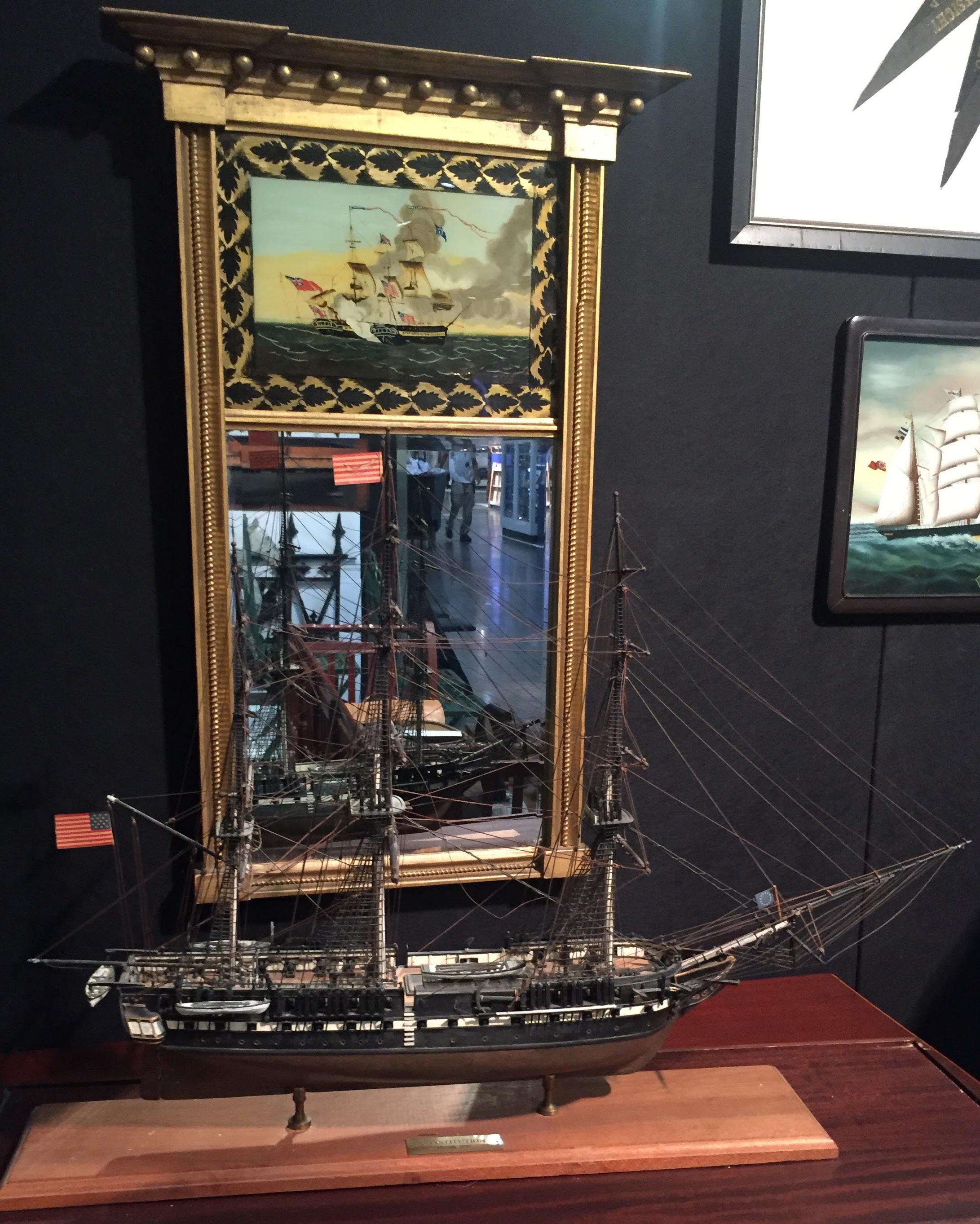

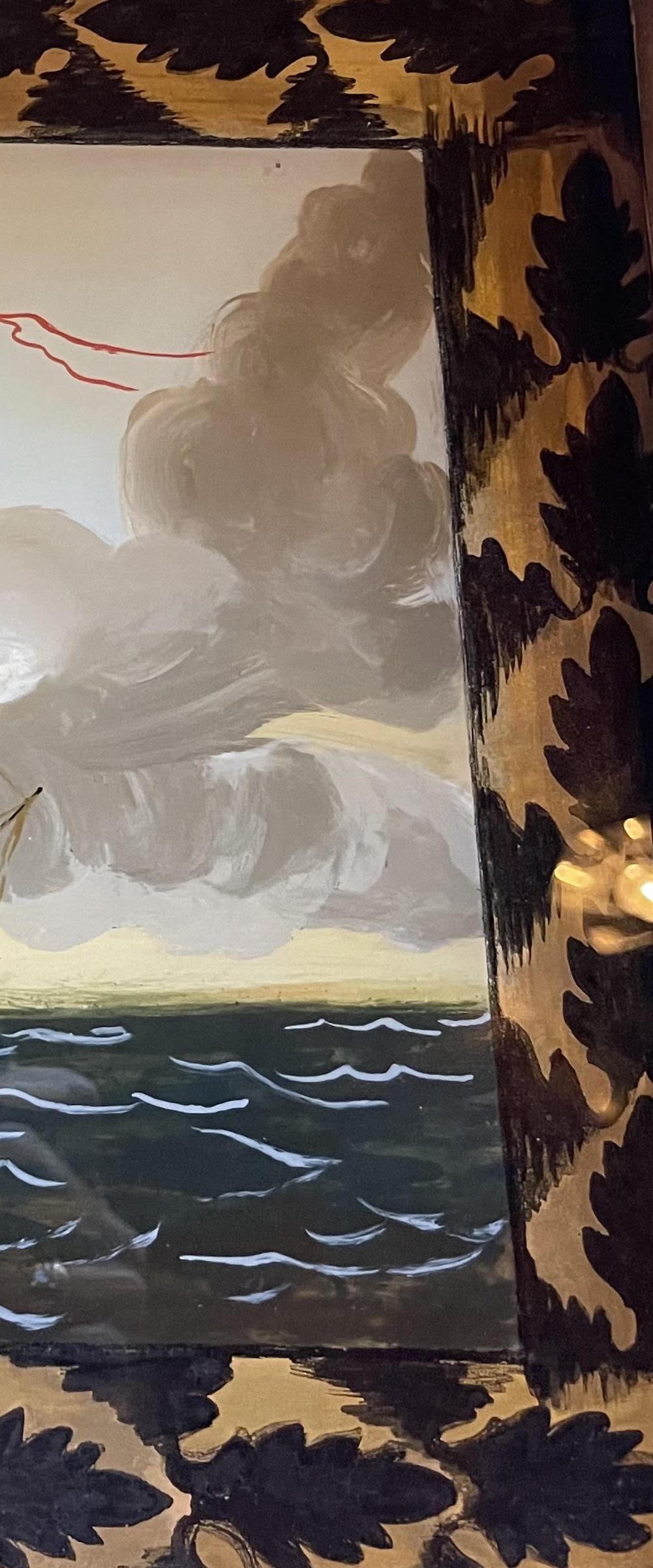
US to blossom as a significant commercial power. This national pride in the young US Navy’s successes and the economic power of the country was reflected in the choice of themes in many of these eglomise panels.
Two of the vessels often seen in eglomise mirror panels, USS Constitution and USS Chesapeake, were among the original six US Navy frigates authorized by the Naval Act of 1794. Congress approved construction of these frigates intended to be larger and more heavily armed than the standard frigates of British and European powers. The intention was for these vessels also to have excellent speed and handling, allowing them to outsail their opponents.
Figure 1 shows an excellent example of a mirror with an eglomise panel portraying the victory of USS Constitution, led by Captain Isaac Hull, over HMS Guerriere, led by Captain James Dacres. The battle took place southeast of Halifax, Nova Scotia on August 19, 1812, a few months after the US declared war on Britain. Since Guerriere had been one of the Royal Navy ships most active in stopping and searching American vessels, Constitution’s victory was greeted with great rejoicing. The victory was the first time the fledgling US Navy defeated a major world naval power, making Captain Isaac Hull a national hero. It was not surprising that this frigate battle would become a favorite theme for patriotic mirror panels. Many of the eglomise panels of Constitution and Guerriere contain stylized borders of laurel or oak leaves, which viewers at the time would have recognized as symbolic of victory and strength. Such a border can be seen in Figure 2.
Built of American live oak frames and white oak planks, Constitution was both larger and more substantially built than her opponent. Cannonballs appeared to bounce off the strong ship, leading a Constitution crew member to exclaim: “Her sides are made of iron,” which gave rise to her life-long nickname of “Old Ironsides.” The 44-gun heavy frigate Constitution actually had about 54 guns mounted at the time of this battle, while Guerriere, classed as a 38-gun frigate had 44 total guns mounted. With her greater number and size of guns throwing a broadside weight of 754 pounds to 528 pounds for Guerriere,
Constitution mauled Guerriere, knocking off her mizzenmast. Guerriere fell into Constitution which sent a second broadside into her at point blank range. The ships broke free, but Guerriere lost her remaining two masts and was forced to strike.
In September of 1812, William Bainbridge replaced Isaac Hull as the captain of Constitution. On December 29, 1812, Captain Bainbridge led Constitution in a single ship battle against HMS Java off the coast of Brazil. Constitution, with her 54 guns, outgunned Java, a “38-gun frigate” actually carrying 46 guns. Java was a formidable ship, but at this time, was manned by a new crew with only a day of gunnery practice. Java outmaneuvered Constitution, but the Americans’ more experienced gun crews were able to totally dismast Java and force her to surrender. Constitution’s wheel was destroyed, but her crew was able to mount a tiller to her rudder and retain steering. Bainbridge received a serious thigh shrapnel wound but remained in command. Constitution survived a direct hit with an 18 pound cannon ball to one of her thick masts, furthering her reputation as the ship made of iron. Given the great distance to any US port and the severity of the damage, after removing all her crew, Bainbridge opted to burn Java. The fire ignited Java’s powder magazine and the ship exploded. Figures 3 and 4 show this dramatic conclusion to the battle with Constitution. This scene is based on the last of a set of four aquatint engravings of the battle drawn by Nicholas Pocock (English 1741-1821) published by Messrs. Boydell & Co (London) on January 1,1814 that would have been in circulation at the time the panel was painted. Constitution’s capture of Guerriere and destruction of Java and the October 1812 defeat of HMS Macedonian by USS United States represented three major defeats for the Royal Navy in only four months. This significant string of victories by a tiny US Navy with only about twenty vessels stunned Britain with its powerhouse 600 vessel Royal Navy.
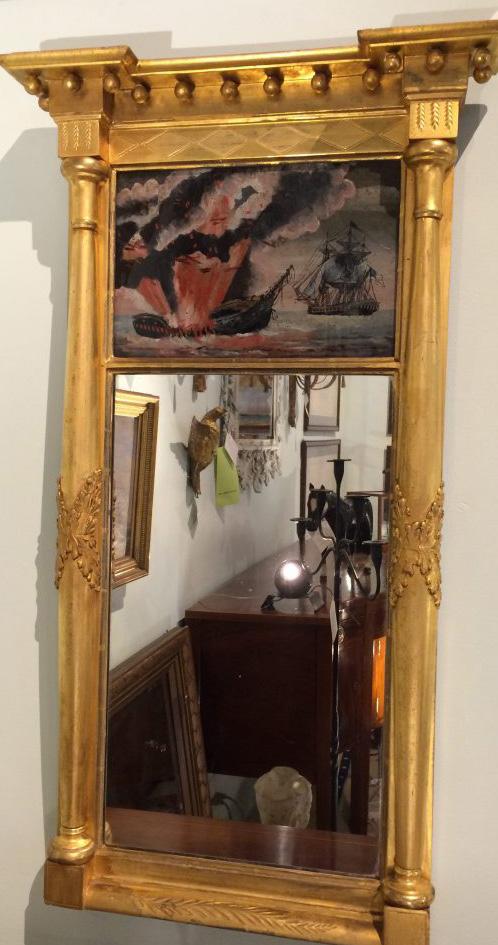
Continue on page 09
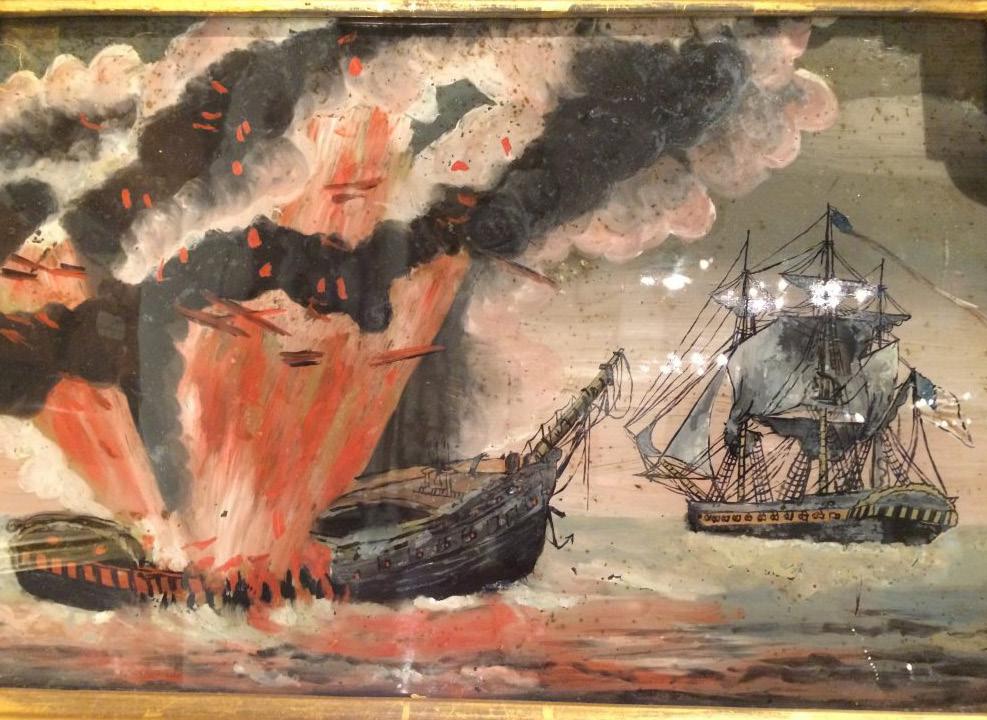
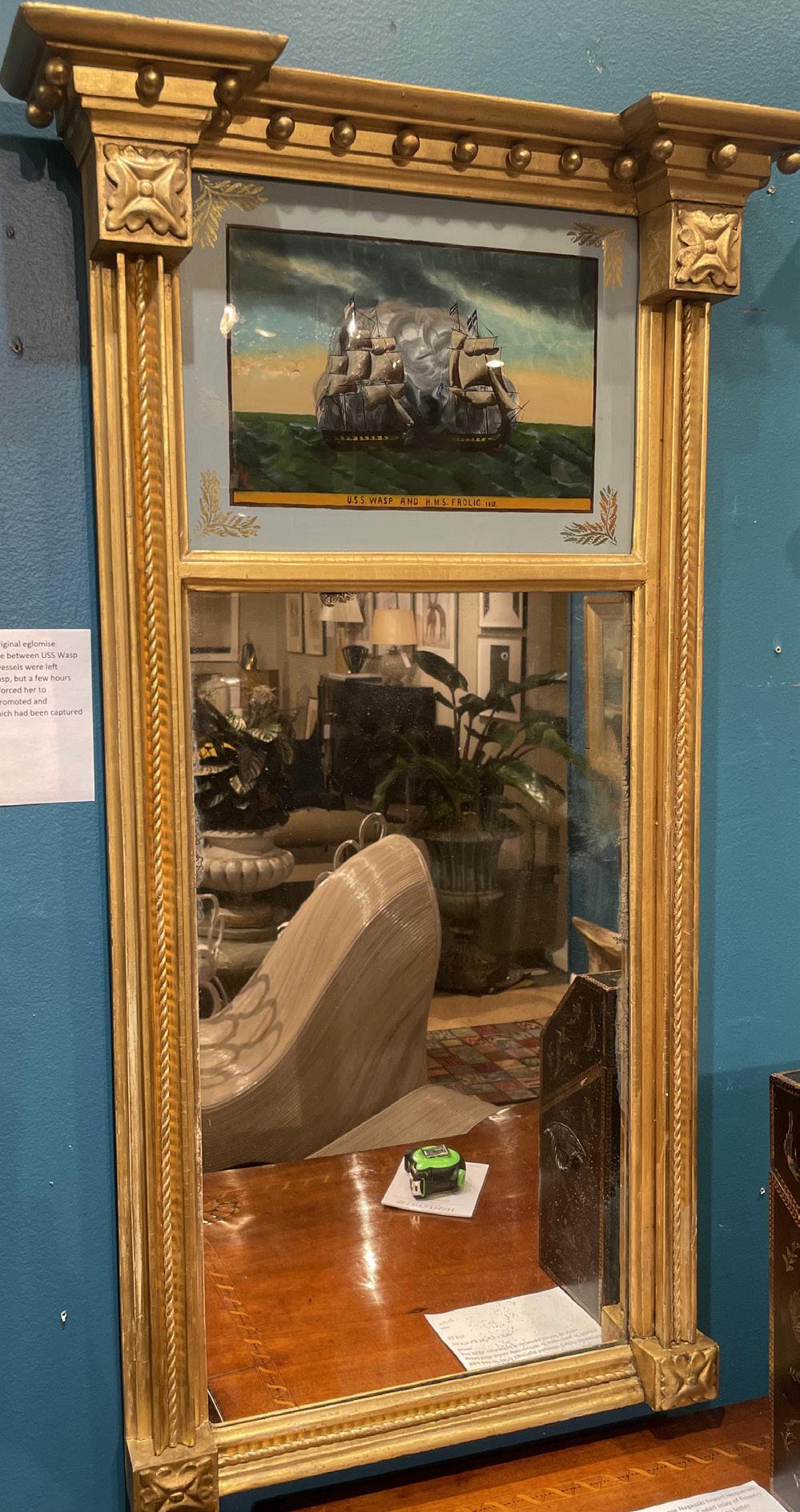


Figures 5A and 5B show the War of 1812 battle fought October 18,1812 between the sloop USS Wasp, under the command of Master Commandant Jacob Jones, and the brig-sloop HMS Frolic, led by Commander Thomas Whinyates. Wasp fired low to hole Frolic’s hull, while Frolic fired high to tear Wasp’s rigging. Both vessels were severely damaged. As the Americans boarded Frolic, they found every officer and over half her crew dead or wounded. Wasp captured Frolic, but very shortly thereafter both vessels were recaptured by a larger Royal Navy ship.
The pair of eglomise panels done as facing ship portraits, in their original bird’s eye maple frames, shown in Figures 6 and 7 commemorate the Battle of Boston Harbor, fought June 1, 1813, between USS Chesapeake, one of the original six commissioned US Navy frigates, and HMS Shannon. Shannon had been blockading Boston Harbor for quite some time. Constitution was still in Boston undergoing extensive repairs after her battles with Guerriere and Java. USS President was able to slip out of Boston Harbor, evading Shannon. Following his victory over HMS Peacock, James Lawrence had just been promoted to captain and given command of Chesapeake one month before the battle with Shannon. Captain Philip Broke had sent a letter challenging Lawrence to come out of Boston Harbor and meet Shannon in a two-ship duel. Lawrence apparently had already sailed out of Boston flying three American ensigns and a large white flag with the slogan “Free Trade and Sailors’ Rights,” a rallying cry of the War of 1812, before he received the challenge. The two ships were evenly matched, but Broke’s more experienced crew inflicted heavy damage on Chesapeake, destroying her wheel and severing her main topsail halyard, crippling her. In the fight, Lawrence was mortally wounded. As he was carried below deck, he gave what became one of the US Navy’s most famous orders: “Don’t give up the ship; fight to the last man.” In a battle lasting only 10-15 minutes, over 250 men were killed or wounded. Chesapeake was forced to surrender. Given the powerful impact of Lawrence’s last order, it is not surprising to see this battle commemorated, despite the fact that it was an American defeat.
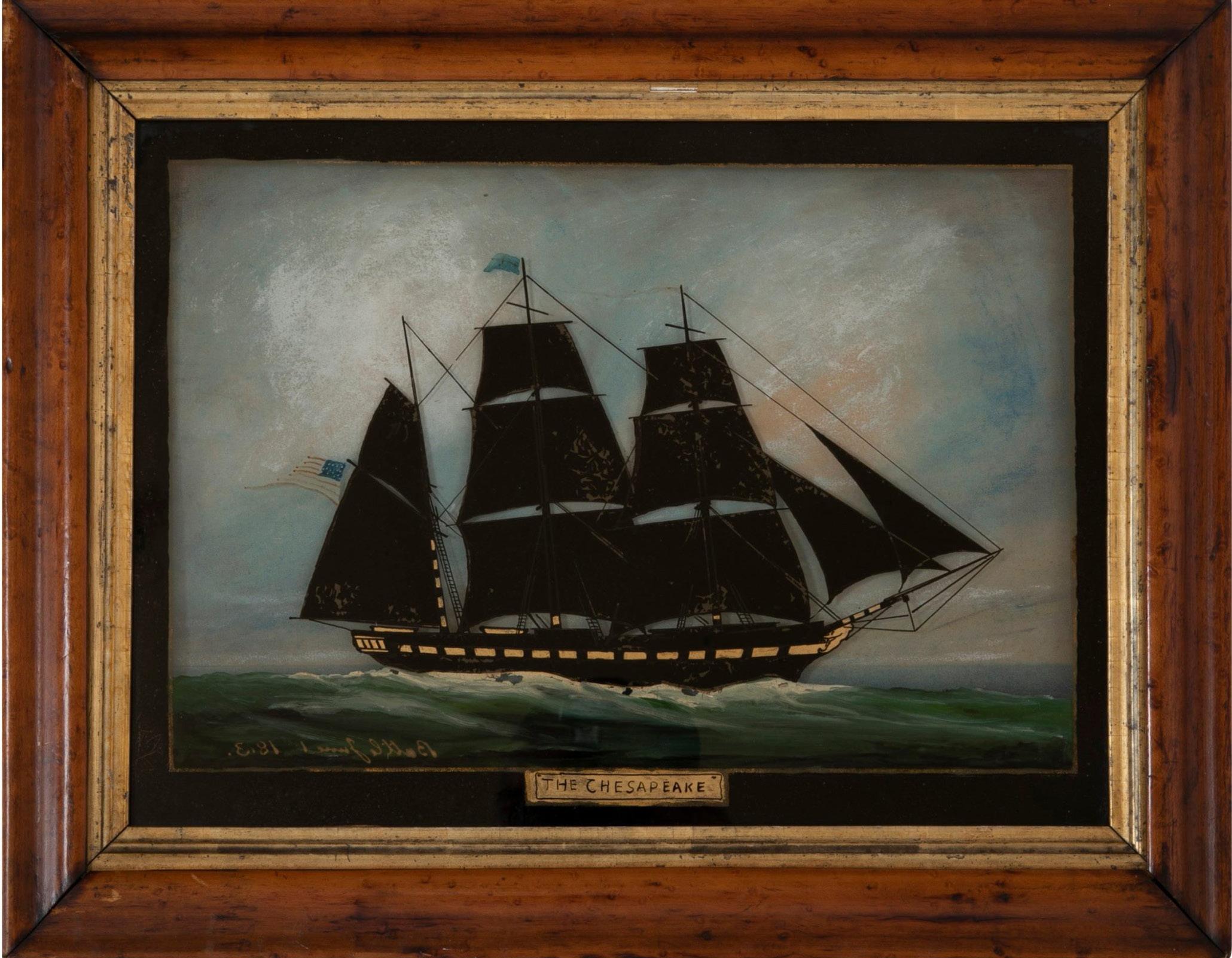
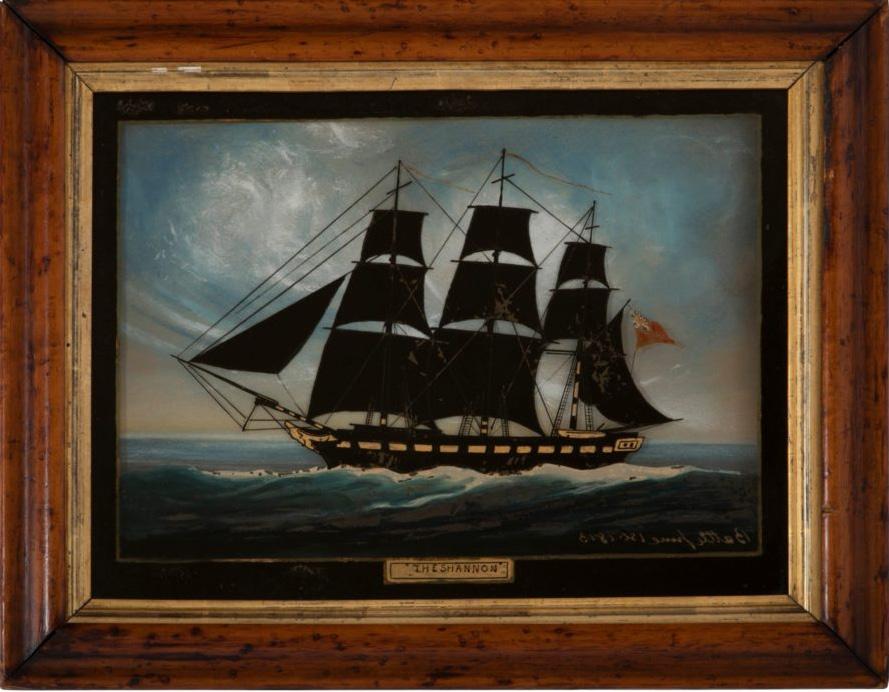
Figures 8 and 9 show a mirror with an unusual eglomise panel entitled “Perry’s Victory” celebrating the victory of Commodore Oliver Hazard Perry and his nine vessel US Navy fleet over Robert H. Barclay’s six vessel Royal Navy fleet in the Battle of Lake Erie fought off Put-in-Bay, Ohio on September 10, 1813. Perry led from his flagship, USS Lawrence, named for Captain Lawrence of the Chesapeake, flying a battle flag bearing Lawrence’s dying words
“Don’t Give Up the Ship.” Perry sailed his fleet directly into the British fleet, resulting in the almost complete destruction of the Lawrence. He shifted his command to her sister ship, USS Niagara. Perry’s victory in the Battle of Lake Erie was quite significant, as it allowed the Americans to retake Detroit from the British and control Lake Erie for the remainder of the war. His victory led to American successes on the Niagara peninsula in 1814 and removed the threat of British attacks on Ohio, Pennsylvania or western New York. In what became another US Navy legend, Perry sent a message to General William Henry Harrison following the battle which read: “We have met the enemy and he is ours.” Given the importance of this naval victory and his well-known stirring words, it is understandable that Perry’s victory would be featured on an eglomise panel.
Pride in the country’s recent military success and in the principle of American freedom is clearly shown in eglomise panels such as the one in Figure 10 containing a clutch of American and battle flags with a “Liberty Cap” and sword. The “Liberty Cap” or “Phrygian Cap” was a common symbol of freedom and liberty. The peaked caps were worn in classical Greek times by free men and similar caps were placed on the heads of freed Roman slaves. The Roman goddess “Liberty” was often portrayed carrying a peaked cap placed on the tip of a spear, called a pileus. This panel also features a large central covered funerary urn, often called a “Washington Urn,” a symbol honoring the death of George Washington.
Figures 11 and 12 celebrate the increase in American economic power which followed the end of the War of 1812, with a
Continue on page 17
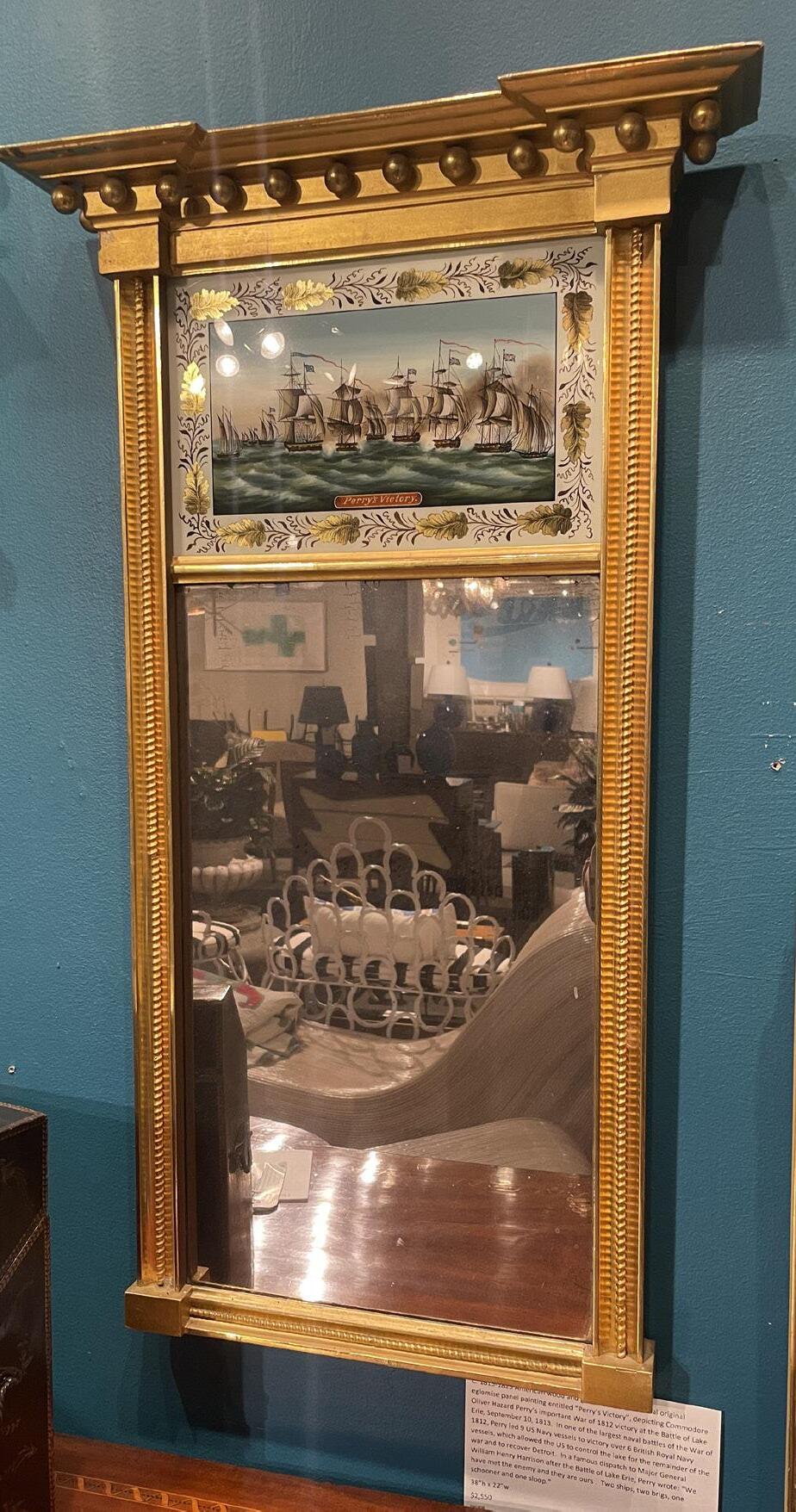

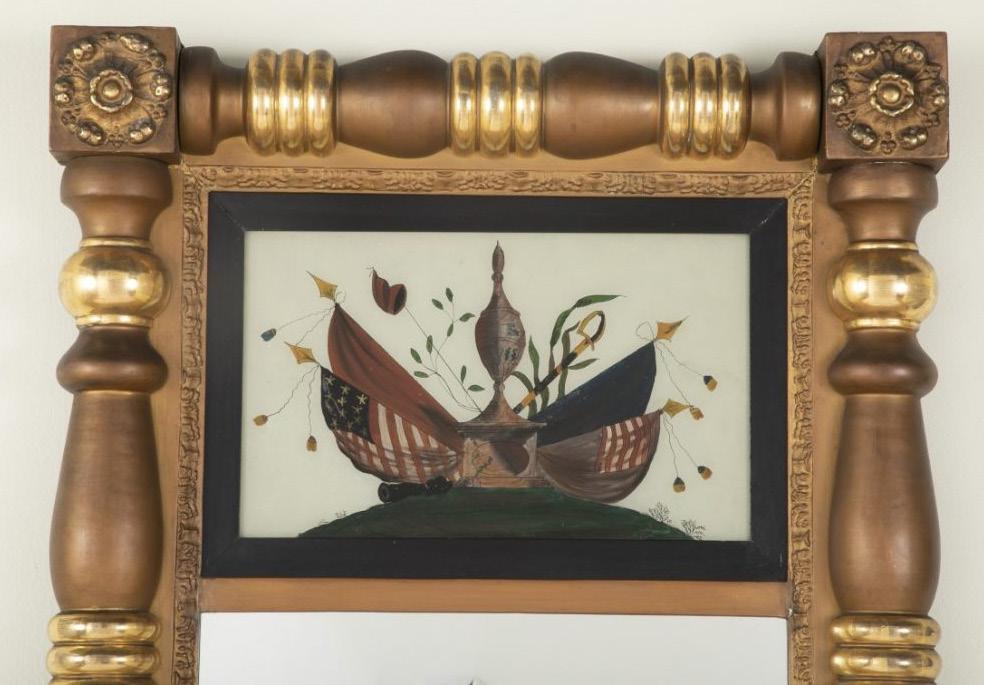

11 - “Agriculture” and “Trade” Mirror

Figure 12 - Detail "Agriculture" and "Trade"
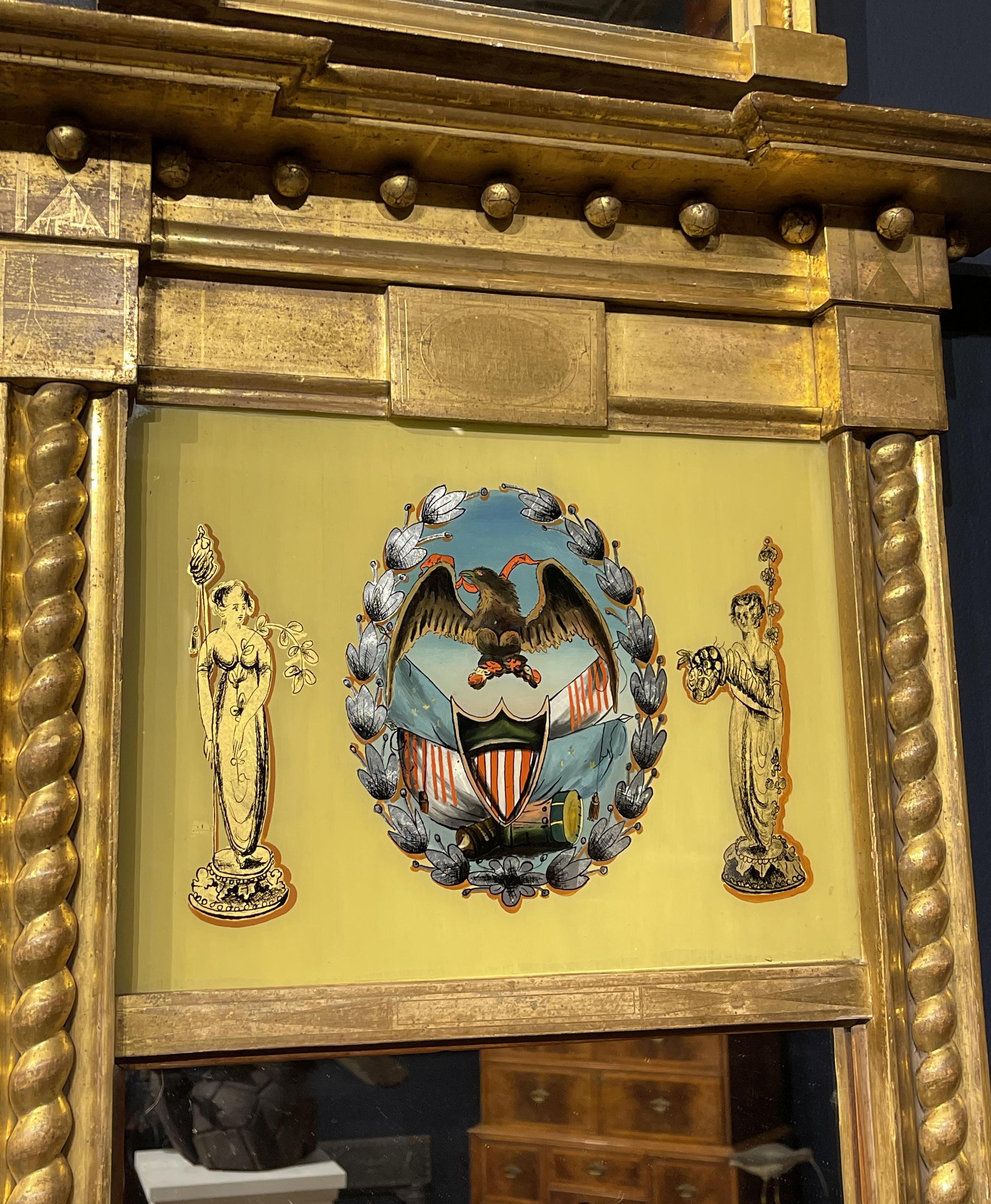

classically draped female figure holding a scythe, symbolic of agriculture, and a male figure dressed as a sailor, symbolic of trade, flanking an American flag shield with a spread wing eagle clutching arrows who soars over their shoulders. Figure 13 is another great example of patriotic pride and economic power expressed in eglomise panels. The eagle has a snake in his mouth, symbolic of American victory over Britain. The eagle and the American flag shield are flanked by classically robed figures of “Liberty” (left) with a liberty cap, or pileus, on the end of her spear and “Plenty” (right) with her cornucopia filled with wheat sheaves.
As part of the increased patriotic fervor following the War of 1812, it also was popular to use eglomise panels to honor George Washington, the beloved general and president. Figures 14 and 15 show an elaborate wood gilt mirror with carved eagle and swagged chain with an eglomise panel with numerous patriotic elements, including American and battle flags, liberty cap, cannon and shot and the words “Washington Rest in Heaven,” perhaps painted to commemorate an anniversary of Washington’s 1799 death.
The panel in Figure 16 contains a riot of patriotic imagery, including rows of weapons, trumpets, battle flags and a large eagle atop a portrait of George Washington.
After more than 200 years, many of these eglomise panels have missing or flaking paint. They are excruciatingly hard to restore. Very few artists can repair them. One artist who did beautiful eglomise restoration for me said: “Please don’t be in a rush for this—I can only work on it when I’m in exactly the right mood.” The work is hellishly intolerant of missteps. Early 19th c. glass was thin and is now very brittle. When we take these pieces to shows, they travel on cushions in the back of our car. When we sell them, we will not ship them by mail, as the glass is just too delicate. Over 200 years, mirror glass has often oxidized and become cloudy. I love the soft, dreamy quality of early mirror glass. I tell customers: “You aren’t going to put on your makeup looking in this, are you?” While we always prefer these eglomise mirrors to have their original mirror glass and
backboards, the fragility of the materials doesn’t always make that possible. My main interest is in the quality, subject matter and condition of the eglomise panels. I will not dismiss a great example because it has replaced mirror glass or backboards. Of course, these condition issues affect price.
These eglomise panels reflect national pride in re-established American sovereignty, pride in increased American commercial power, respect for American founding principles and reverence for figures, such as George Washington, who had done so much to further those principles. Let’s hope we can continue to preserve these fascinating pieces of American history and find new owners who honor the principles of liberty and freedom expressed in their imagery.
words by Ann Wilbanks
The Find Weatherly collection features fine art, folk art and furniture with a particular emphasis on marine, animal and folk art, interesting metal pieces and 18th and 19th century American furniture. We buy what we love. There are also always interesting English, French, and Asian pieces as well as an unusual collection of whimsical pieces in stock.
FIND WEATHERLY, LLC
www.findweatherly.com ann@findweatherly.com (203) 858-3087
Avery & Dash Collections: 101 Jefferson Street, Stamford, CT, 06902

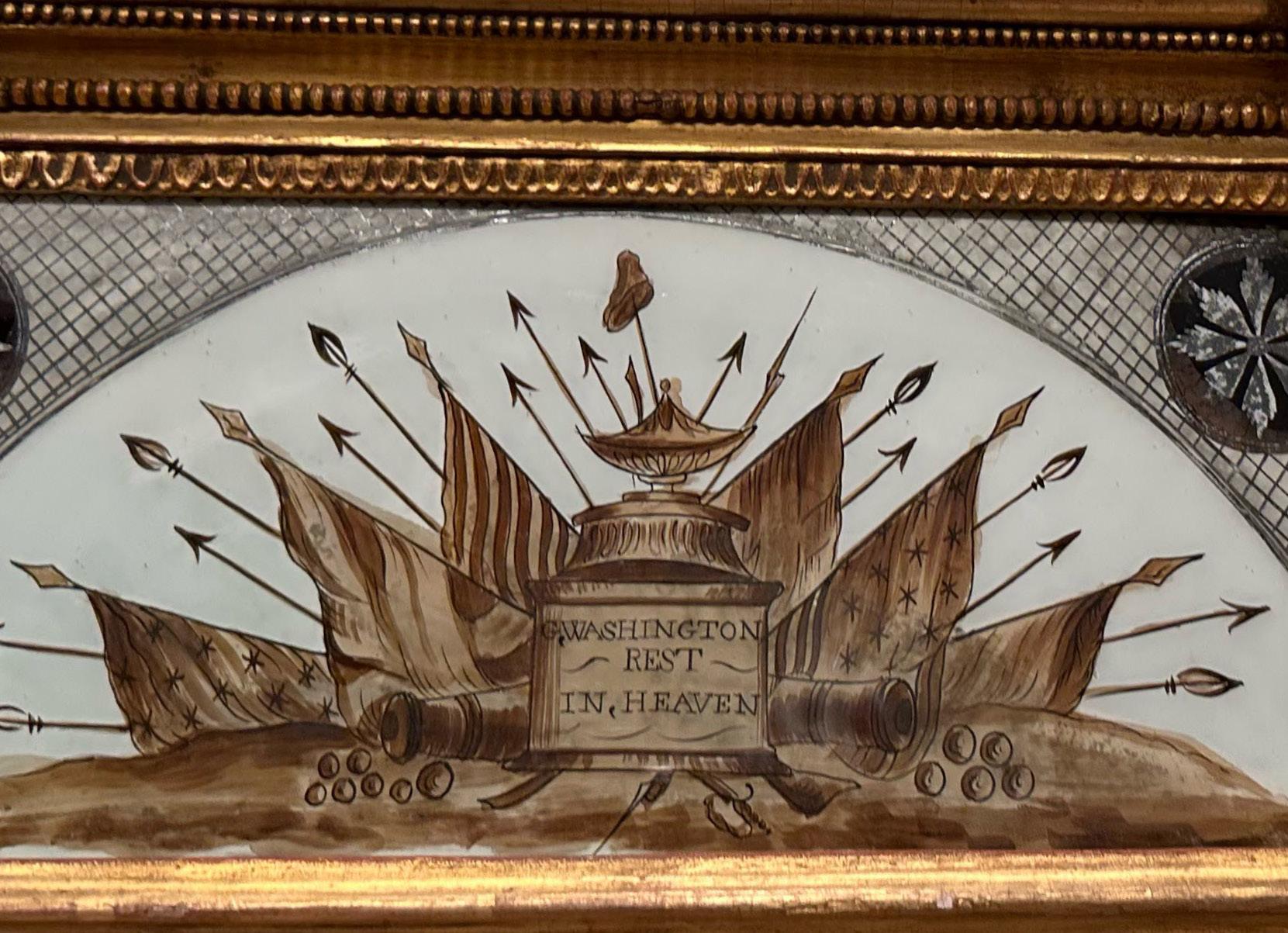
1 of 4
William Stanley Haseltine (1835–1900)
Sunrise at Narragansett, Rhode Island, 1863 Oil on canvas, 18 ¼ x 31 ¾ in.
Signed and dated lower right: W.S. Haseltine, N.Y. 1863
Provenance: private collection, New York, until 2016
Born in Philadelphia to a family of talented artists (all of his brothers were involved in artistic pursuits, and his son, Herbert became a sculptor), William Stanley Haseltine began his studies at the University of Pennsylvania and received his degree from Harvard University in 1854. When he returned to Philadelphia, he studied art under Paul Weber, before departing for Germany in 1855. Haseltine quickly became one of the leading figures among the group of American artists in Düsseldorf, and in 1856, accompanied his artist friends Emanuel Leutze, Worthington Whittredge, and Albert Bierstadt on a sketching trip down the Rhine and to Italy. Haseltine returned to the United States in 1859, joining Leutze, Whittredge, and Bierstadt in the famous Tenth Street Studio Building, and began his painting excursions to the New England coast.
Haseltine’s paintings reflect an important movement in midnineteenth century America, namely, the belief that art’s purpose was best expressed through the accurate depiction of nature, and that the science of geology had the authority to rival biblical accounts of the earth’s creation. In addition, the writings of English art critic and philosopher John Ruskin had spawned an American Pre-Raphaelite school devoted to the close replication of nature. Haseltine accomplished his remarkable accuracy through intense on-site studies, which he
Continue on page 21
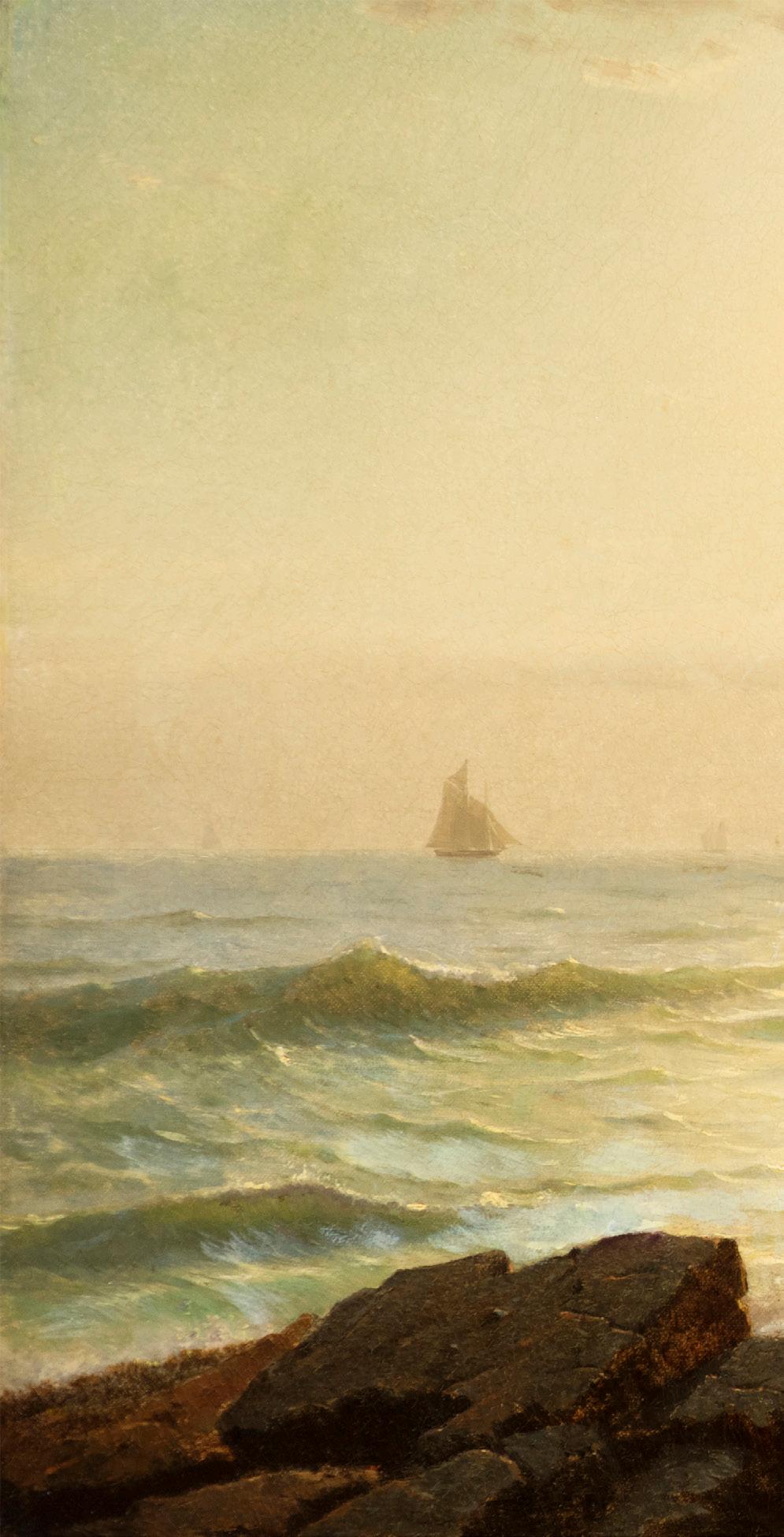

later reworked in his studio, using minute brushstrokes. Haseltine drew and painted scenes of the New England coast more than any other subject during his few mature years in America. Sunrise at Narragansett, Rhode Island is a prime example from this important period in Haseltine’s oeuvre. He worked in a most detailed manner with a yellow and blue color palette that suggests a sense of light and air. The rock formations are accurately detailed and true to nature, and the manner in which the waves break on the rocks and the sunlight dances on the water demonstrates Haseltine’s intimate familiarity with this coastal locale.
2 of 4
Henry Alexander (1860–1894)
Sunday Morning, 1883
Oil on panel, 22 x 17 ¼ in.
Signed and dated lower right: H. Alexander / 83 –
Provenance: Thomas B. Clarke, New York, 1883; Christie's East, American Paintings, May 23, 1995, lot 2; Godel & Co., 1995; private collection, Charleston, South Carolina, c. 1996-2024
Exhibited: American Art Gallery, New York, The Private Collection of Paintings by Exclusively American Artists Owned by Thomas B. Clarke, December 28, 1883-January 12, 1884, no. 2.
Henry Alexander was one of the most brilliant genre painters active in San Francisco and New York in the late nineteenth century. Born in San Francisco, he studied at the California School of Design, and traveled to Munich in 1877, where he entered classes at the Royal Academy. Influenced by his teachers there, he adopted the tightly painted, detailed realism derived from Dutch seventeenth-century genre and figure painting.
Alexander returned to New York City late in 1883. Through his close friend, fellow artist Charles Ulrich, he immediately gained the patronage of Thomas B. Clarke, the country’s foremost collector of contemporary art. Clarke immediately acquired Sunday Morning, which had just been completed in Munich. Alexander showed his paintings the following year at both the National Academy of Design and the Society of American Artists, and by March of 1884, had returned to San Francisco, where he became one of the city’s foremost painters of figures in interiors, including domestic scenes and exotic Chinatown rooms. He continued to be extensively lauded in the California press after he returned to New York in 1887, and his work was included in the World’s Columbian Exposition held in Chicago in 1893. Surely due to his amazingly
Continue on page 24

precise technique, Alexander’s output was limited, and his paintings today are quite rare, even more so because a great number of his pictures were lost in the 1906 San Francisco earthquake and fire.
Sunday Morning, representing an elderly woman reading a picture book in a high-ceiled, sunlit room, conforms to a popular theme among late nineteenth-century genre painters who favored subjects of old age or youth or sometimes a combination of both. What sets Alexander apart is his fascination with every object and detail of both the interior and the exterior. He very consciously places equal focus upon each object: the elaborate wire birdcage, the woman’s sewing utensils, the ragged piece of carpet beneath her chair, and her heavy, detailed garments. The floorboards are uncarpeted and uneven; a group of small pictures—mostly graphics—hangs somewhat haphazardly on the wall. The flourishing plant is unpruned, and even the one item of elegance, the glassenclosed clock at the extreme left, is cut off in the composition. Sunlight streaks through the window but barely reaches the woman or her book. Outside in a seemingly untended garden, red flowers are flourishing. In this brilliantly painted composition, Alexander has created a work of great poignancy.
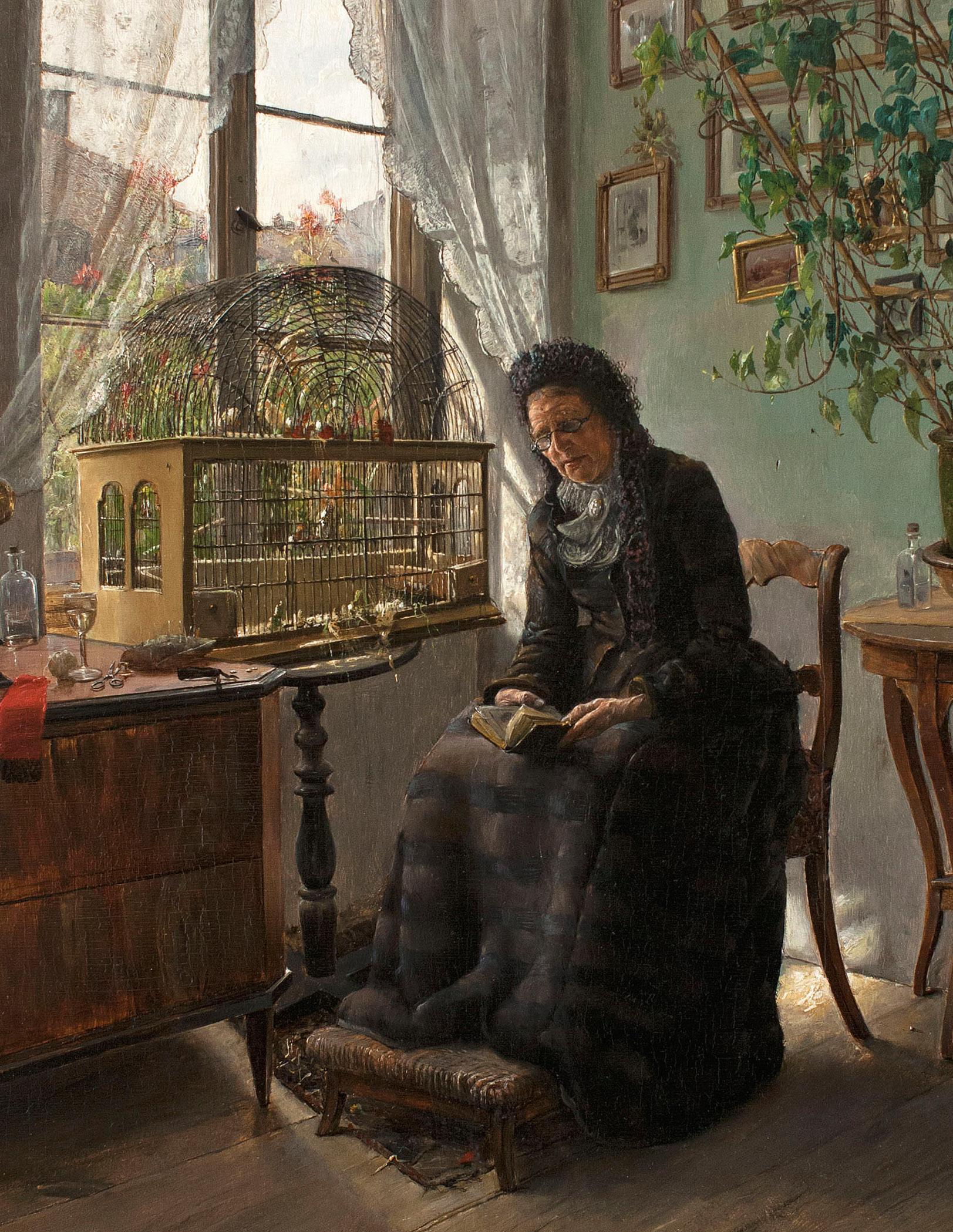
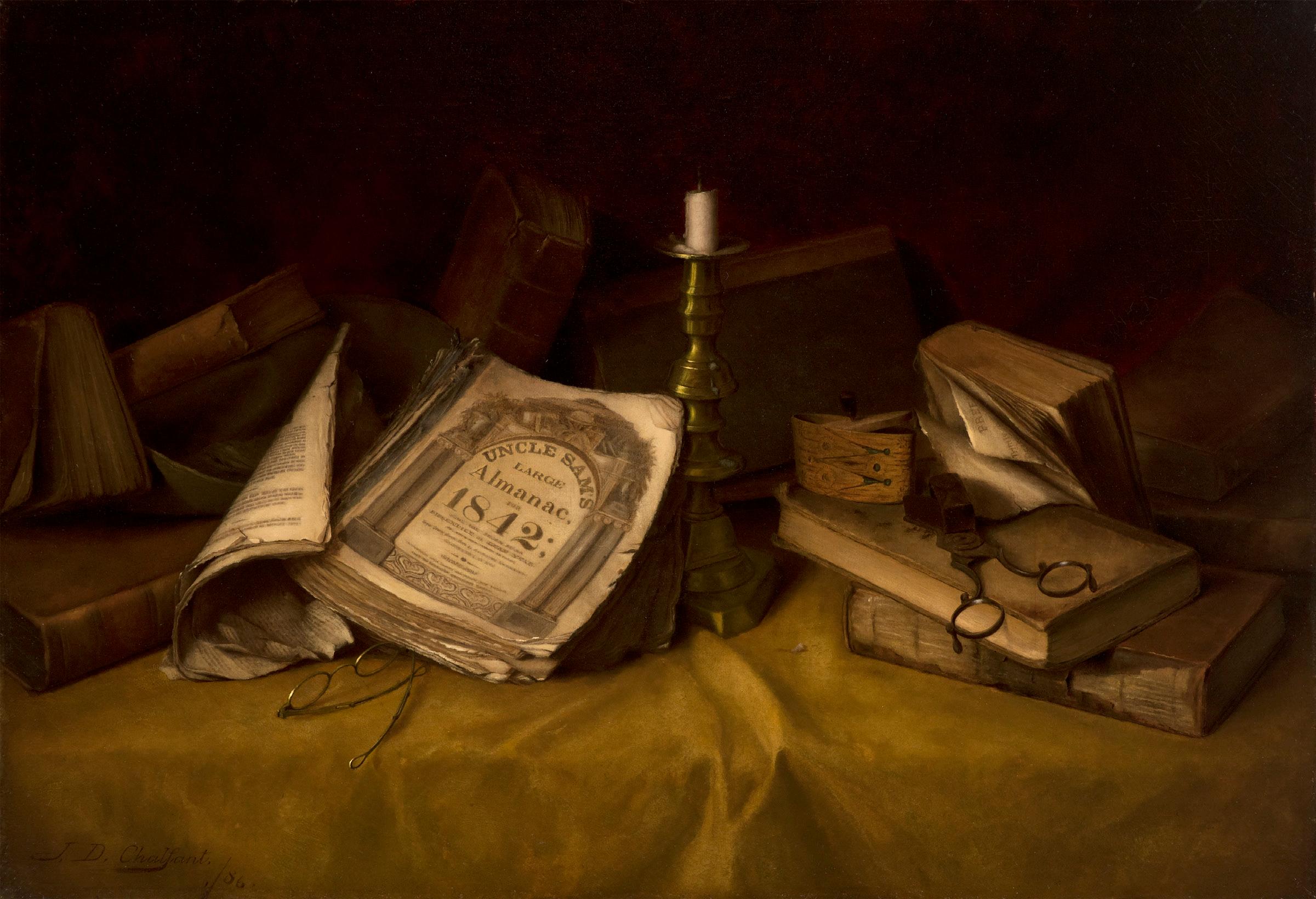
3 of 4
Jefferson David Chalfant (1856–1931)
The Old Almanac, 1886 Oil on canvas, 17 ½ x 25 5/8 in.
Signed and dated lower left: J. D. Chalfant 1886
Provenance: Mrs. John B. Derrickson, Newark, Delaware, by 1959; Mr. and Mrs. A. William Boyle, York, Pennsylvania, 1983; H. Brooks, Harrisonburg, Virginia; Richard Manoogian, Grosse Point, Michigan, 1989; Masco Corporation, 1992-2016
Exhibited: C. D. Rudolph. Jeweler, 231 Market Street, Wilmington, Delaware, November 1886; Wilmington Society of the Fine Arts, Jefferson D.
Chalfant 1856-1931, January 8 – February 1, 1959, no. 2; Berry-Hill Galleries, New York, Virtual Reality: American Trompe l’Oeil Paintings, May – June 1994
Literature: Jefferson David Chalfant Papers, Archives of American Art, microfilm roll 2427, frames 99, 104, 111, 594; William H. Gerdts, “A Trio of Violins,” The Art Quarterly, vol. 22, Winter 1959, 377
Born in Sadsbury Township, Chester County, Pennsylvania, Chalfant moved with his family in 1861 to Lancaster, Pennsylvania, and followed his father’s trade as a cabinetmaker. By the 1880s, Chalfant was living in Wilmington, Delaware, which would remain his home for the rest of his life. By 1883 Chalfant opened a studio as an artist, and he appears to have begun his artistic career as a landscape painter before switching to still-life painting by 1885. Chalfant is best known for his trompe l’oeil paintings, inspired by the work of William Michael Harnett. Harnett’s return to New York City in 1886, after six years of studying abroad in Munich, brought attention to trompe l’oeil effects.
The still-life period of Chalfant’s cereer ended when Alfred Corning Clark, a great New York collector, sponsored his travel abroad to study in Paris at the Académie Julian in 1890. His studies focused on the human figure, and after he returned from over a year and half in Paris, he focused on genre paintings, often depicting children, elderly artisans at work, and male figures in historical costumes.
The Old Almanac is Chalfant’s earliest located painting. It displays aspects of trompe l’oeil, especially in the folding of torn pages next to the almanac and the puckered cloth underneath the arrangement on the table. The one identifiable book in this scene is Uncle Sam’s Large Almanac for 1842 (Uncle Sam’s Old Almanacs were published in Philadelphia by William W. Walker). Also included are a candle, which stands up in the center, its glowing metal stand beautifully contrasting with the texture of paper and cloth, and a candle snuffer and a snuff box at the right, resting upon a book. The painting as a whole suggests that it is not only a fascinating arrangement of objects of different form, texture, and date of origin, but also that this is perhaps a specific memorial. The picture may well be a reference to a life “snuffed out” with the candle now unlit and a reference back to the year 1842—perhaps to the year of birth of a deceased friend or relative, or to a figure of note, presumably male, given the snuff box. This premise in still-life painting, a “memento mori,” was especially popular in The Netherlands during the seventeenth century, though Dutch pictures of this theme usually display a greater variety of objects and are more colorful. The dark tones and lack of color here especially underscore the mournful but evocative pictorial projection of Uncle Sam’s Large Almanac for 1842.
4 of 4
Robert Gwathmey was born in Manchester, Virginia. He studied at the Maryland Institute of Design in Baltimore and at the Pennsylvania Academy of the Fine Arts. He traveled to Europe in 1929 and 1930, and again from 1949 to 1950. He married Rosalie Hook, of Charlotte, North Carolina, in 1935. Gwathmey taught for most of his career, first at Beaver College in Glenside, Pennsylvania, then at the Carnegie Institute of Technology in Pittsburgh, and at the Cooper Union in New York City. In New York he was represented by ACA Galleries from 1941 to 1961 and subsequently by Terry Dintenfass, with whom he had a long affair. He retired to Amagansett, Long Island, near the artists’ colony at East Hampton.
After teaching in Philadelphia and Pittsburgh and painting a mural for the Federal Works Agency during the 1930s, Gwathmey established his reputation in the early 1940s with sympathetic images of African American sharecroppers in the South. Although his artistic career was far removed from their poor, hardworking existence, he visited their farms and even picked tobacco at a North Carolina farm in 1944 in order to accurately represent their experience. At a time of increasing awareness about the racial divide, especially in the South, Gwathmey’s images of sharecropping symbolized the unequal status quo that had existed since Reconstruction.
As Abstract Expressionism became popular during the 1940s, Gwathmey stuck to figural representation as the best way to convey his social realist message. His early and frequent use of commercial imagery in works such as The Gathering, however, presaged the techniques of Pop Art in the 1960s.
Gwathmey usually treated a single figure or a small group of figures engaged in everyday life, but he occasionally painted more ambitious, large-scale works depicting an entire community. One such work, The Gathering, depicts an African American community composed of humble shacks, a church, and a few stores, partially silhouetted against the pale orange of a sunset sky. Gwathmey indicated the buildings’ functions using the store signs he remembered from his childhood in Virginia: an open scissor indicates the barbershop, a large shoe the cobbler, and stained glass the church. Gwathmey also included the gaudy advertisements that embellished poor Southern towns at that time, such as the bottle and pack of cigarettes by the general store in the foreground. The “666” also advertised on the store’s wall was a popular cure-all sold throughout the South, and Gwathmey may have used it as a symbol for Southern self-deception, or more literally, as a grim reference to the Apocalypse. Men and women in working clothes congregate in front of a restaurant serving “Fish Fresh,” others peer toward them from neighboring
Continue on page 30
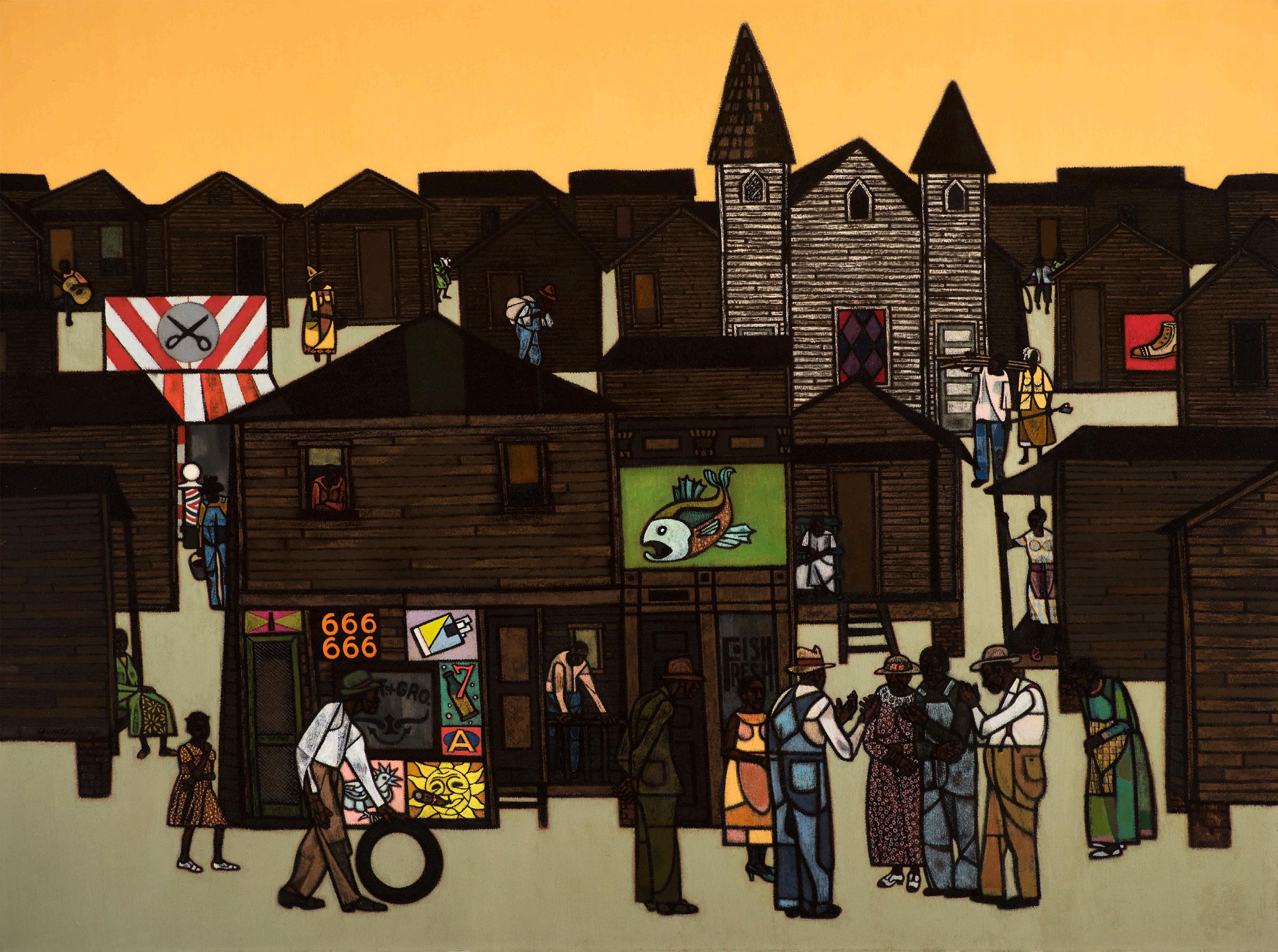
4 of 4
Robert Gwathmey (1903–1988)
The Gathering, c. 1959 Oil on canvas, 36 x 48 in. Signed lower left: Gwathmey
Provenance: the artist; Harry Belafonte, New York; ACA Galleries, New York; Manoogian collection, Michigan, until 2011
porches, and still others emerge from the background and appear to approach the central gathering. Some carry the implements or fruits of their labor, while a young boy dances as he strums a guitar, and a man rolls a spare tire.
Gwathmey painted such town scenes beginning in the 1940s, often reusing symbols such as “666,” which appears in From Out of the South, c. 1941 (Smart Museum of Art, University of Chicago). The same church is depicted in Hoeing, 1943 (Carnegie Museum of Art), and a number of elements, including the bottle, cigarettes, scissors, fish, and the cobbler’s shoe can be found in Saturday Afternoon, 1949 (collection of Mr. and Mrs. Sherle Wagner). Following The Gathering and the successful Civil Rights movement, Gwathmey painted another village scene, United, 1969 (private collection), featuring an integrated gathering of residents arm in arm.
GODEL & CO., INC.
www.godelfineart.com info@godelfineart.com 914-205-3695
26 Village Green Bedford, NY 10506
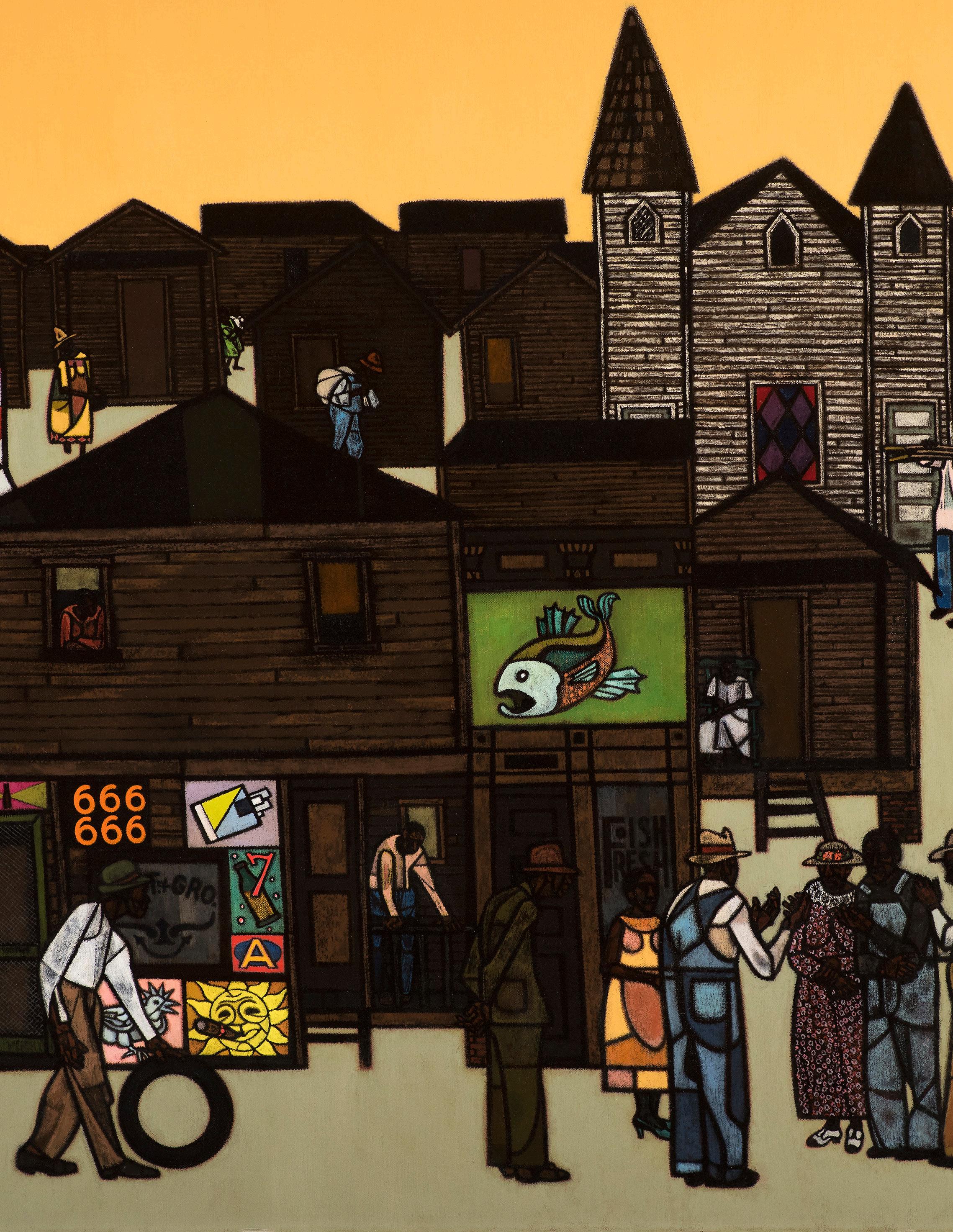
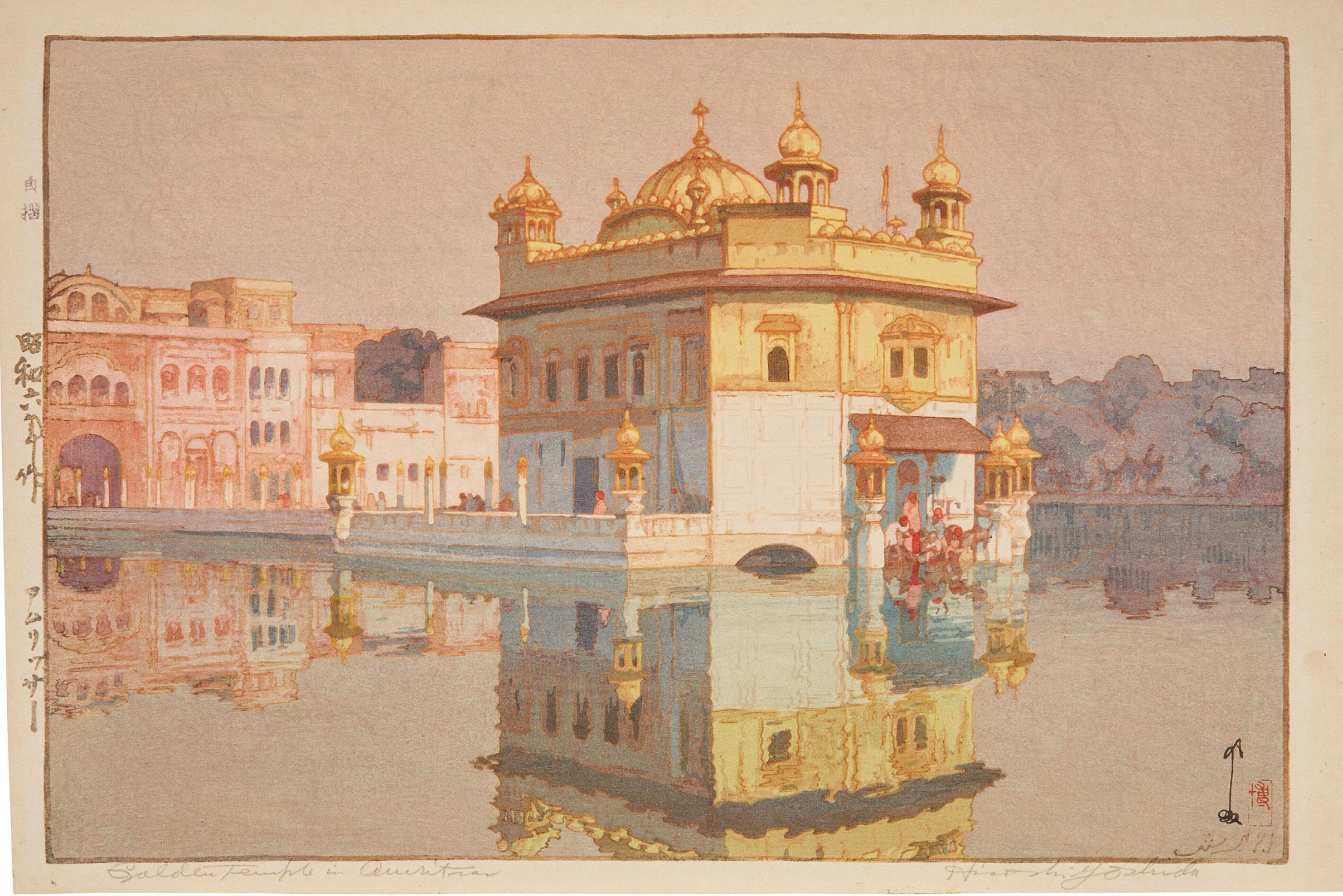
KAPOOR GALLERIES www.kapoors.com info@kapoors.com (212) 888 - 2257 34 East 67th St, FL 3, New York, NY 10065
NEW YORK – Kapoor Galleries proudly presents Heightened with Gold, a 2025 spring exhibition and accompanying catalog that commemorates the gallery’s 50th anniversary and role in advancing global appreciation of the ancient and classical fine arts of India and the Himalayas. Heightened with Gold honors the multi-generational leadership of Kapoor Galleries dedication in procuring and showcasing a distinguished collection of artworks which have captivated collectors, scholars, and the public for over half a century— bringing ancient craftsmanship and spiritual narratives into contemporary discourse.
(On left)
Woodblock Prints by Hiroshi Yoshida from the Series: India and Southeast Asia (1931-1932)
Golden Temple in Amritsar (Amurissaa) 1931
Woodblock prints, signed Yoshida, in pencil in Roman script Hiroshi Yoshida, on left margin sealed Jizuri (selfprinted)
Horizontal oban: 10 5/8 x 15 3/4 in. (27 x 40 cm.)
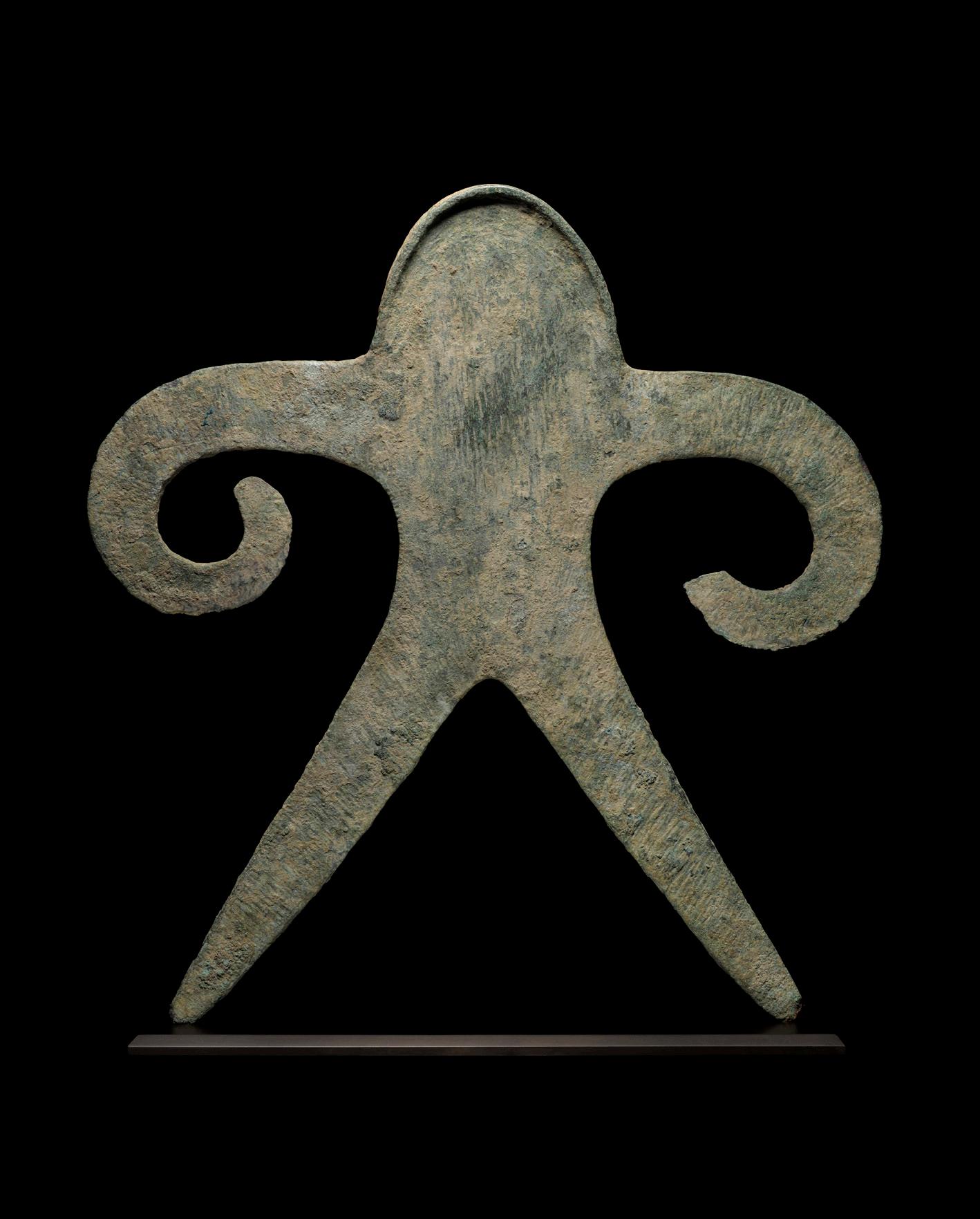
An Ancient Indo-Gangetic Anthropomorphic Figure
Uttar Pradesh, India, circa 1700-1200 BC Copper 17 in. (43.18 cm.) high
Exhibited: Carlton Rochell Asian Art, Frieze Masters, The Regent’s Park, London October 12 - 16, 2022.
Provenance: A Private Collection, New York, NY, acquired in 2003. Carlton Rochell, New York.
Available Documentation: Analysis and Materials Science for the Preservation of Cultural Property: Scientific Examination of a Gangetic Copper Idol by John Twilley, Art Conservation Scientist (June 1, 2023).
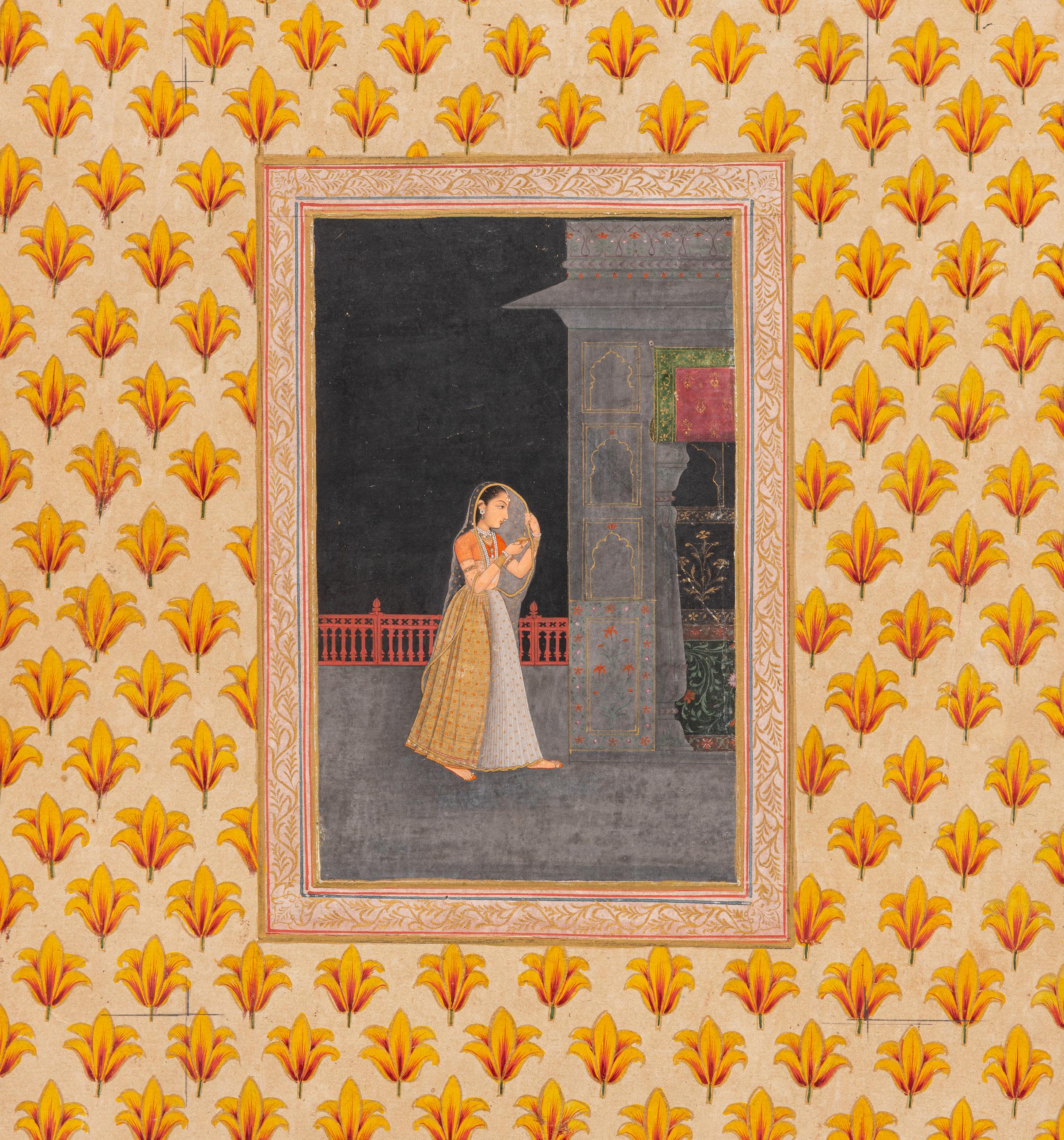
Princess Strolling Across a Palace Terrace at Night
Lucknow, Awadh, India, circa 18th century
Gouache painting on paper heightened with gold leaf
Image: 7 1/8 x 4 7/8 in. (18.1 x 12.4 cm.)
Folio: 17 x 12 in. (43.2 x 30.5 cm.)
Provenance:
Doris Wiener Gallery, New York, September 30, 1969 (documentation available upon request).

Jamini Roy (1887–1972)
Untitled (Woman Standing)
India, circa 1920
Tempera painting on cardboard 27 x 14 ¼ in. (68.6 x 36.2 cm.)
Provenance:
Private New York collection.
Private Pennsylvania collection.
After India’s partition in 1947, Shri Prashotam Ram Kapoor, a passionate reader, began a library in Jalandhar which consisted of a collection of manuscripts and rare books that catered to displaced Indian refugees. It soon expanded into the arts through acquisitions from neighboring libraries, including Pahari paintings, illustrations of sacred Indian texts, and historic sculptures. Prashotam was later joined by his son Ramesh Kapoor in the 1960s, and together fostered relationships with museums and academic institutions. Their dedication led to the sale of a renowned Kashmiri bronze, Swachhandabhairavi, to the National Museum in New Delhi in 1964, a globally recognized piece featured in multiple publications, including Dr. Pratapaditya Pal’s The Arts of Kashmir.
Ramesh and his wife, Urmil, immigrated to New York in 1975, founding Kapoor Galleries Inc. and expanding the collection into the 20th and 21st centuries, while also playing a pivotal role in growing both public and private collections across the United States. The collection has evolved from ancient manuscripts, to the inclusion of works on paper, rare books and illustrations, miniatures, thangkas, bronzes, sculptures, and a selection of modern artworks showcasing the breadth of craftsmanship across Asia. Sanjay Kapoor, the gallery’s fourthgeneration leader, notes, “It is both an honor and a privilege to carry forward the legacy that my grandfather built. Kapoor Galleries has always been more than a business—it is a family’s dedication to preserving and sharing the rich artistic traditions of South Asia.”
The gallery has also played a vital role in public education on the ancient and classical fine arts of India and the Himalayas through in-house and collaborative exhibitions. It has also enriched institutional collections worldwide, with museum accessions made by The Metropolitan Museum of Art, the Los Angeles County Museum of Art, the Ancient Civilizations Museum in Singapore, and the Princeton and Yale University Art Museums. Additionally, the gallery hosts public and private tours of the collection and regularly collaborates with curators, art historians, and educators at institutions on research, translations, and scholarly projects.
Continue on page 36
Heightened with Gold: Celebrating 50 Years at Kapoor Galleries reflects the Kapoor family’s unwavering commitment to preserving and honoring a millennia of South Asian artistic traditions which have continuously inspired the captivated audiences globally. The catalog, which comprises 80 artworks and objects, aims to cover the region’s rich history and artistic splendor. It opens with ancient sculptures and objects such as the Indo-Gangetic Anthropomorphic Figure from around 1700 BC and guides viewers to the prized miniature paintings of India that depict powerful deities and royal figures such as, Princess Strolling Across a Palace Terrace at Night, circa 18th century. The catalog continues on to explore the meditative thangkas of Tibet and the cross-culture influences in India throughout history, shaped primarily by Mughal and British rule, which introduced new artistic styles such as Company School. The journey ends with modern artworks, including a painting by Jamini Roy and woodblock prints by Hiroshi Yoshida, both of whom drew upon ancient techniques and traditions, reinterpreting them to create innovative works that bridge the past and present.
Kapoor Galleries is delighted to celebrate its golden anniversary with the opening reception of Heightened with Gold: Celebrating 50 Years at Kapoor Galleries on March 13, 2025, from 5:30 to 7:30 PM. The exhibition will feature a rotating selection of artworks from the catalog through May 23 and looks forward to sharing this milestone with the community.
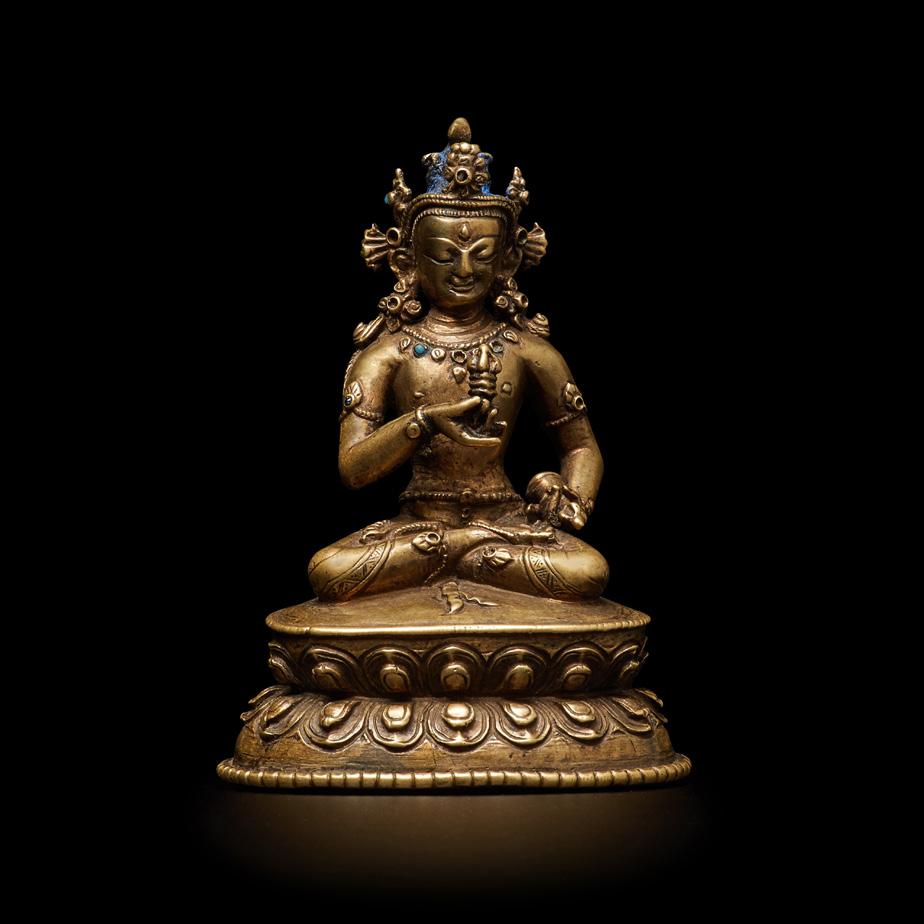
Figure of Vajrasattva Tibet, 14th century Bronze 3 1/2 in. (9 cm.) high
Published: Himalayan Art Resources, item no. 61643.
Provenance: Cees van der Plog, 1995, by repute. Bonhams Hong Kong, 2 Oct 2018, lot 132.
KAPOOR GALLERIES www.kapoors.com info@kapoors.com
(212) 888 - 2257
34 East 67th St, FL 3, New York, NY 10065

Arhat/Sthavira (Buddhist Elder) with Multiple Figures Tibet, 1600-1699
Lineage: Gelug and Buddhist
Ground mineral pigments and gold on cloth 23 5/8 x 17 ¼ in. (60 x 43.8 cm.)
Published: Himalayan Art Resources, item no. 24887.
It was about ten years ago when I received a call from Tony Blumka to come to his gallery to discuss the developing situation on ivory. Up to that point, ivory was being traded in the world of art and antiques without too much consternation from anyone. But Barack Obama was President and Hilary Clinton was Secretary of State and they had been convinced by African leaders that the depredation of elephants would soon lead to their extinction and that further trade in ivory was benefitting terrorists and their like. Both Clinton and Obama could safely back any restrictions on the trade in ivory and be almost one hundred percent certain that it would be a popular policy. And so, the U.S. government, in its capacity as a regulator, set into motion the mechanics that would lead to a banning of the import of all ivory. A number of states added further restrictions to that ban with outright bans of any trading in ivory. New York was one of those states.
The meeting at the Blumka Gallery was to introduce us to a lawyer whose specialty was in the arts field, Michael McCullough. Michael quickly outlined the threat we were facing—a straight ban on the import and export of any and all ivory, no matter how old the ivory was and the possibility of a NY State ban on trading any ivory, no matter the age. This news was more than alarming as most dealers in furniture and in the decorative arts including silver dealers, dealers of objects such as netsukes or Chinese constructions, miniature painting dealers, porcelain dealers whose wares were often in original boxes with ivory clasps were all in the same boat—all of it was to be banned and, ergo, valueless. It was an alarming meeting, a wake up call to a struggle that is ongoing.
Continue on page 39




In light of what I’d heard, I was advised that it might be good to attend a U.S. government information session that was to be held in Virginia and where attendees would be given fifteen minutes to speak their minds, pro or con, about banning ivory. I worked diligently to put together a short two page presentation on ivory using statistics from CITES about how much illegally imported ivory was coming to the U.S. At the time, we were tied with Germany as 46th on the list for illegally imported ivory, a trifling amount compared to East Asian countries where ivory carving is a long established tradition, not to mention three dimensional constructions with incredible detail, some being over three to four hundred years old.
The information session was, I can only say, a rigged affair. All of the honorary members of the committee were bumps on a log as the committee chairman paddled through a list of specious claims about illegally traded ivory funding terrorism. What the chairman did not say anything about was why elephants are diminishing in numbers, the omission of which was nigh on criminal, which is that elephants are losing land to people. The fundamental reason for elephant depredation is not poachers, it is loss of habitat. Villagers, given the choice of having a plot of land on which to grow food or having an elephant or a herd of elephants as close neighbors, will always kill the elephants. They will then expedite the sale of that ivory to ivory traders. Yes, there are poachers, but it is habitat that elephants need more than anything and that is vanishing as populations rise throughout Africa.
Meanwhile, NY State was doing its best to hop on the anti-ivory bandwagon with a public “ivory crush” advertised as a signal that the western world, America at least, was turning away from having anything to do with ivory. The feel good vibes, the catharsis of no longer exploiting the endangered elephant was echoed in all the newspapers. (My two sisters-in-law both agreed that no trade in ivory should take place.) The publicity put out by the NGOs was heading to a fever pitch. Those of us
Continue on page 40


who had any ivory figured it was better to just put our ivory away and not show it at all. The objective was being met and even surpassed as NY State decided that no ivory could be sold within state boundaries to residents or to someone standing in your gallery. If you wanted to trade ivory, you had to take it out of state to sell it.
We funded lobbyists to work on the NY State legislators to no avail. Michael said that the wave of opposition was just too great and so we were left without recourse to recoup, at the least, our investment in items that were antique artworks which clearly had no affect on the elephant depredation. The illogical aspect of all this was overtly dumb—what did something made in 1900 or earlier have to do with elephant de-population today? That was the question that no one would answer. And for those of us who consider what we do as a profession, having bureaucrats tell us that we can’t prove something is antique from the style of an object is a little like saying that our understanding is based on greed. Dealers pride themselves on their knowledge—no one wants to sell a fake or a modern copy.
Our obvious go-to resource for defense, of course, was the Metropolitan Museum of New York, an august institution that has as many pieces of ivory in the first twenty-five yards of the entry as a dealer might sell in ten years. Surely, we could count on the museum to back us up in this fight to keep antique ivory in the marketplace? This thought proved to be wishful thinking, even though many of the curators were appalled that such laws were being enacted. The administration was loath to enter into the fray as politics is something they prefer to stay out of. I understand the hesitancy—museums count on multiple layers of funding and they neither want to annoy legislators nor backers by appearing to be too involved in a cause that the newspapers had ginned up to being life or death for the elephants. As dealer groups, it was to be our fight alone.
Scott Defrin has been on the Board of the Art and Antique Dealers League of America for a good long time, well over ten years. Scott’s business, begun by his father, is called European
Continue on page 41
Decorative Arts, and Scott, along with his family, have had considerable success in being in a field that is far more crowded in Europe than it is in the U.S. Their business is to find unique, one-off items, no matter what material or what culture they come from. It is an exacting business with a clientele that is bent on owning unique items, often backed up with extensive research. It’s the kind of business that requires a lot of investigation as well as knowing where to look. Inventory is key to such a business.
More than any of our businesses in the AADLA, European Decorative Arts found the passage of laws by NY State a kind of body blow. Furniture dealers can choose not to buy pieces with ivory escutcheons around key holes, silver dealers can eschew tea pots with ivory insulators and if worst comes to worst, an ivory handle of escutcheon could be replaced with ebony or some other timber. It is the kind of thing that goes against the grain of professionals—to alter a piece for no good reason other than for a poorly thought out law—but if you are looking at a Chippendale library table with ivory lettering, for example, would you change the ivory if you wanted to sell it to someone in England? You might very well. European Decorative Arts wasn’t in such a position—single items made solely in ivory were all of a sudden taboo, whether they were 3,000 year old Sumerian tablets or 120 year old carvings.
There is no answer to bad laws other than trying to get others to see why they are bad laws. Bad laws are always written at the crest of a public outcry. Prohibition was a terrible law, a terrible amendment and it had to be reversed. We seem to have more bad laws on our books than ever, all designed to curtail individual freedom based on either the wishes of a minority or due to public outcry from well aimed publicity campaigns. Laws of this type are all subject to repeal, but it requires a certain disposition to get the matter brought to a head. What this means is that someone has to stick with the process of pushing for common sense even though it isn’t common sense that rules the day. Almost any well informed individual can understand that elephants are dying because of loss of habitat, Continue on page 42


but few understand that a well intentioned law has far reaching consequences for others—in this case, the art and antiques community.
European Decorative Arts in the form of Scott and his sister, Mindy, have spent the last ten years sticking to doing something about this poorly written but well meaning legislation from the NY State Legislature. Through hard work and some luck, a libertarian law firm took up the gantlet to go after NY State about one specific aspect of the ivory laws—to wit, the ability to show ivory within the state. It is a small detail, but one with major consequences. In essence, if you are allowed to show ivory in your gallery, a lawsuit that was successfully pursued, why then can’t you sell it to someone? That aspect of the law has not been challenged, but is about to be, we hope, in an appeal to the Supreme Court. The law firm arguing for us is saying that there is a preemption of Federal law by the state, in other words a contradiction by New York State to what is allowed by the Federal government.
Do I wish the Federal law was less restrictive? Most definitely, but if our friends in Europe see that we can muster some common sense (I only hope that our case is accepted by the Supreme Court as that is, as yet, undetermined) within the United States, perhaps some of the more restrictive laws within Europe can be toned down as well. The key, as far as I can see, is the professionalism that antiques and arts groups maintain as proof of their intentions to abide by common sense laws regarding the sale of antique ivory.In turn we condemn the sale of any sort of new ivory and we would like to see stricter laws for people attempting to promote such trade. Finally, we wish to be recognized as professionals in our respective fields, working to save cultural history from ignorance and fear and the bandwagon of righteous indignation.
words by Clinton Howell



My daughter, part of my firm, is about to have a 2nd “one man” show at the Medici museum in Florence. I have just received the announcement that will accompany the invitation. It is in Italian, so I will translate it so if you wish. Please see below:
"From February 28th to May 4th, 2025, at the “Specola” museum in Florence, there will be an exhibition entitled Terra Incognito (The Unknown Earth) by Arianna Fioratti Loreto, organized in collaboration with Marco Masseti. She has drawn, especially for this exhibit, seventy works of medium and large format to celebrate the natural and animal world using the antique technique of ink on paper with cross hatching.
A book with her illustrations by Marco Masseti is to be published with the detailed description of the characteristics of the biological and morphological of animals that really existed and those generated by mythological fantasies from ancient Greek Mythology, Central America, Asia plus others of pure imagination!
Mythological subjects, such as the l’Idra, Dragon, l’Ouroboros, Cipactli and Quetzalcoatl are accompanied by fantasy subjects such as the beeelephant, the bear-wasp, the fish-boar and the marine star. All seeing that even extinct species have their place in this exhibit, such as the terror bird, the dwarf, elephant, the Ceratosaurus and the Moa in conversation with its fossil brothers, which are present in the Medici Museum collection from the real to the interpreted.
Arianna Fioratti Loreto is a graduate of Harvard University in Medieval Studies, has a Masters in Art History from Princton and all but her thesis for a PhD. She has had various exhibitions at the Eerdmans gallery and Boerner gallery in New York. The Bassenge gallery in Berlin, the Stephen Ongpin in London, Tefaf Maastricht and New York.
The “Specola” museum, Via Romana 17, Florence, is open Tuesday through Sunday from 9am-5pm, last entrance 4pm."
words and translation by Helen Fioratti

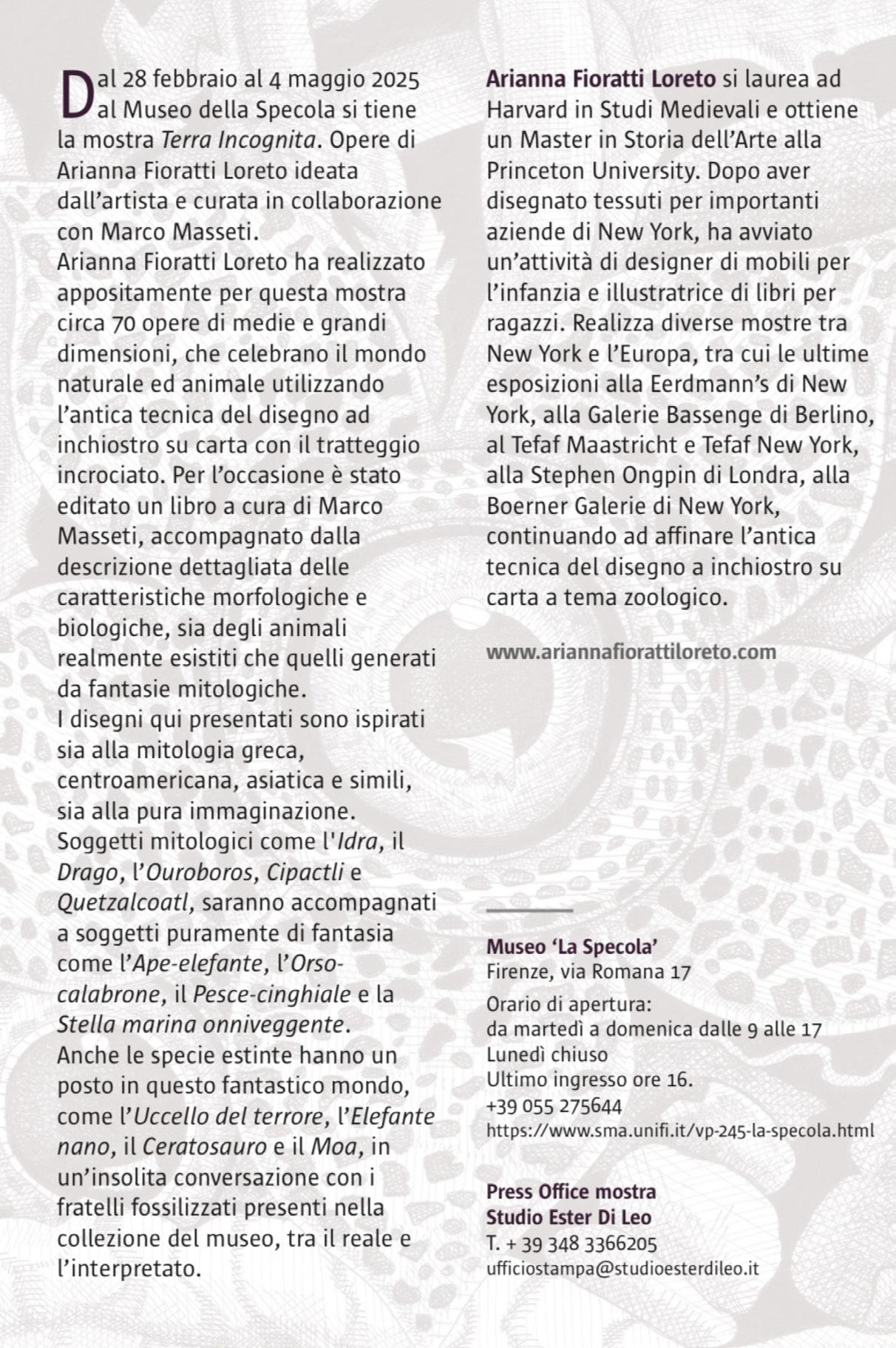
Perhaps we should go back to over a hundred years ago.
One can attribute the eventual founding of our firm to the payments my mother received from her uncle as a young girl for going to bed on time.
My mother, her sister, and their mother traveled to Europe several times a year accompanying her father, who was an important surgeon and was called to Europe for difficult cases!
Mother went to school in France and Germany, as well as New York, and developed a taste for Gothic and Renaissance art. She disliked the Tiffany lamp era and her room decor at the family's house on 61st Street between Park and Lexington Avenue. With the money from her uncle, she was able to redecorate her room at home with the furniture and objects she bought in Europe.
To learn more, she became an intern for a German art historian-dealer in New York. She enjoyed the education, did not mind not being paid, but when put in charge of his gallery while he was away, she paid her mentors bills. Her father believed a “lady” should not be in business, but she finally had him relent (he had no sons). She opened a gallery in the Flatiron building, which was in the center then for the arts.
The Washington Swedish Embassy, knowing of her knowledge and reliability, encharged her to go to Sweden, catalogue, and bring to New York for sale the contents of Näsby Slott
Continue on page 47

(castle). The town was in dire straits, with unemployment, and the castles’ owner offered his vast collection, which included a Rembrandt, to raise money to hire the towns’ workforce and rescue the towns citizens from penury.
Mother was in her twenties when she was cited by the New York Times (and other publications) as the first female fine arts dealer in America. When she married my father, an Italian banker and diplomat, she gave up her gallery to live in Rome, but continued her work with museums, finding works of art for the collectors of the era.
My early years were spent in Rome. My room was furnished with cheerful lacquered antique furniture. I remember trying to restore some patches on a credenza by using crayons to match the colours on the missing parts. I was five years old.
Mother decided to move back to New York when my brother was inducted into the Balilla, the Mussolini young fascist brigade, which she abhorred. Father was here and there on diplomatic missions. She no longer used her name on the gallery as she didn’t want father’s colleagues to think he was being supported by his wife. She called her gallery The Connoisseur, which is now part of our company’s name.
Her cousin, Dorothy, was a lawyer and suffragette who had laws passed to protect Mother and other women from losing their citizenship if living in the country of a foreign husband. Mother’s sister, my aunt Helen, another celebrated woman, became a famous violinist (with a Stradivarius).
At the gallery on Madison Ave and 63rd St. there were problems too. Unfortunate occurrences included a subway being blasted near enough to The Connoisseur that the explosions shook the building, toppling many 18th century French mirrors displayed in the front area of the gallery. I had graduated from Parsons School of Design and had also a B.S. from New York University at just nineteen. I was the youngest Parson’s graduate. My studies were in interior
Continue on page 48
design. I wanted to design fabrics and wallpapers too. My projects had been admired at school and I prepared a collection and presented it to a large company and was told it had to be shown to the company head. After a time (too long a time) I was told that they were sorry but could not produce a new line then. When I went to the D&D building (Decoration and Design) for my decoration work I was horrified that my designs were on sale in several show rooms. Deciding then to concentrate on decorating, I was really discouraged.
After graduating, I had briefly worked for a decorator who had me do renderings and floor plans of work she hoped to do for a year. Something she would have had to pay for dearly by older professionals. I then worked for The Connoisseur as my mother said that outside work was a waste of my time.
I had shows of my small still-life paintings oil on panel at Count Lanfranco Rasponi’s Sagittarius gallery. Someone had shown him my work, I never had met or contacted him, but he sought me. The shows sold out and the clientele was most prestigious, American society leaders and celebrities. Greta Garbo bought six paintings, the Dutchess of Windsor even more (the check came from Buckingham Palace which intrigued the tellers at the Bankers’ Trust Co. who ran around the bank with it to show everyone). The Greek ship owners also bought paintings, Niarchos, Onassis, and others. I was able to buy an apartment on Park Ave and 62nd St with my earnings. We didn’t think about it then, but a newspaper columnist cited F.F.F. ( “Fine French Furniture”) as the most prestigious style of decor. The ladies of fashion all wanted to have this style at home, it was then the real status symbol. Mrs. Ford from Detroit, like many others, (she had English furniture there) converted to French in New York where life was more glamorous and exciting.
Continue on page 49
The Connoisseur was given the prestigious job of re-furnishing the Oval Office at the Capitol. The patrons knew us well, they themselves were clients of The Connoisseur.
While hunting for pieces for my customers' decoration projects, I saw things they did not need, but bought them anyway if they were fine. When I was married and moved to the bigger apartment, I had all the furniture needed by just having the mover’s trucks unloaded. I still live in the same apartment.
I met my husband to be in Rome where I was to move after marriage and where he was based. Mother said she would give up her gallery, apartment, and life in New York if I left. My fiancé said he would then come to New York instead. My husband, a known journalist, was assigned to New York, the United Nations, and Washington by Il Tempo, Rome’s most important newspaper. He was great driving me around on my decorating errands in our little Fiat 600 car. He enjoyed it so much he said “why don’t we open a gallery too with the periods and things your mother doesn’t handle?” I was not keen as I didn’t want to be tied down to a gallery. I was, anyway, also working for The Connoisseur. He said he would take care of it, but he hardly did as he was busy with his work and our Italian early painting collection. I agreed when we found an attractive space just across the street from mother’s gallery and a showroom on a white stone floor around the corner.
At our L’Antiquaire premises on 73rd st, just off Madison Ave. where we moved after my mother’s death, when the rent had been raised to one million dollars per year on Madison Ave. I also bought the building with my own money, earned again from sales of my paintings. I bought the building to be delivered empty. The former landlord said to give the tenants that had not moved out money so they would, and said he would take care of it. I gave the money which he kept and it took years, and much more money, to clear it. Another damage and loss of art, occurred to Gothic and Renaissance
Continue on page 50

art, this was due to a water main break on Madison Ave, which partially flooded the street level floor, but ruined our below street level show room of early European art which became the likes of a swimming pool, all of the electricity was out too. A frightening sight in the dark was seeing what seemed to be a face down dead body of a man floating in the basement water. With a flashlight, I found it was our 16th century wooden statue. Everything of wood was ruined, the legs of a set of chairs were like sponges under their surface. I was shocked to find that the insurance company was able to put them at Sotheby's with no mention in the catalog that the legs were rotten under their surface veneer.
The Connoisseur gallery would be 90 years old now and when merged in 1981, when mother died, what became my and my husband’s gallery L’Antiquaire has now been in existence for 44 years.
In 2025, I find business very depressing. Clients buying art on the internet and not seeing things in person, a real mistake. I am waiting to see what will happen with the new Trump era.
Words by Helen Fioratti
L'ANTIQUAIRE & THE CONNOISSEUR www.lantiquaire.us info@lantiquaire.us +1-212-517-9176 36 East 73rd Street, New York, NY 10021
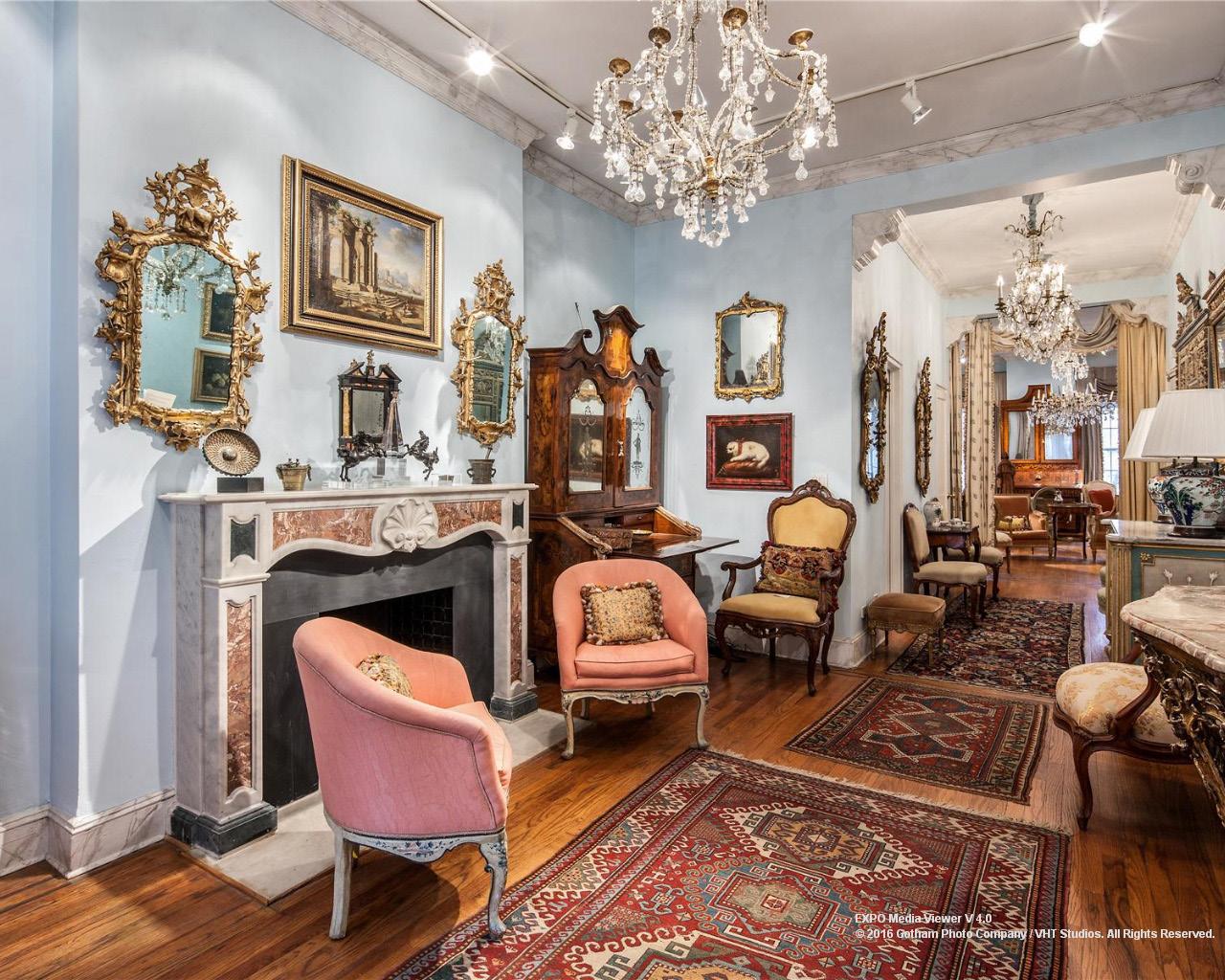
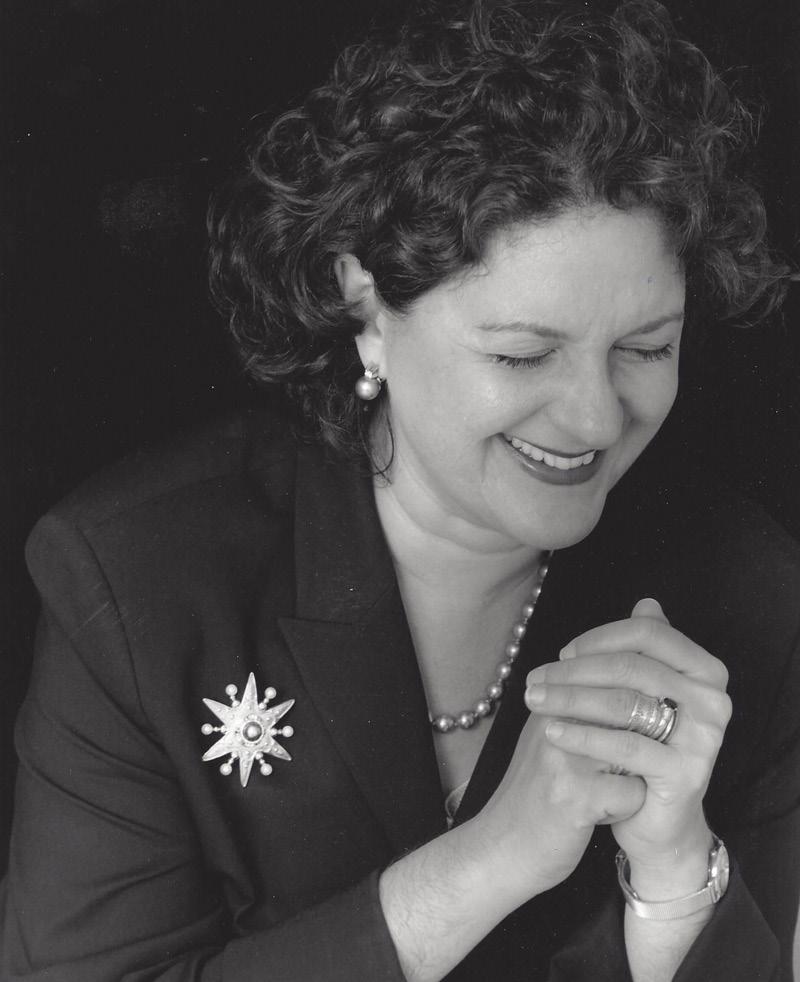
BETTY KRULIK FINE ART LIMITED www. bkrulikfineart.com bkrulikfineart@gmail.com (917) 582 - 1300 260 Birch Lane Irvington New York 10533
No one has ever accused me of being an introvert. I am a joiner, but why? Is it because I love art and objects? Is it because I am a trivia nerd? or just a people (and dog) person? Ultimately, I think it is due to Connections: connections with objects, which elicit emotional responses - from tears from being overwhelmed by a work's beauty. To laughter over an artist's pithy witticism.
But even more so connections with people, especially the sophisticated and knowledgeable folks in our (Art and Antiques) world.
1. My Service Professionals: Conservators, Shippers and Storage team.
2. My Professionals: Legal, Financial and Insurance Professionals
3. My clients: Museum professionals (Directors, Curators, Registrars), Collectors and Colleagues (dealers and appraisers).
I have the utmost respect for the specialized knowledge they have acquired. Fortunately from me, I have friends in their 90s and those in their 30s, all a result of this art world. We are never at a loss for engaging conversation. I am continually learning and bonding with people over objects and experiencesacquiring alot of knowledge along the way. I bet any one of us
Continue on page 53
could be Jeopardy champs, as one of my buddies was. Who needs AI -when we have our colleagues!
Through the arts, our world gets very large! One of your contacts will know someone in every corner of the world, to get you entree into every museum, gallery or event, anywhere. A case in point-I was visiting collectors in Birmingham, AL and while dining with them that evening, I remarked that at the same time the following week I would be in Bangkok. My hosts looked at each other and stopped everything, picked up their phone (I thought that - hmm - unusual). They called their son that very minute, without a word to me until later when they explained, their son was living and teaching in Bangkok. They arranged a meeting for me, and he was my personal travel guide to etiquette and customs in Thailand. Amazing!
As a relatively new AADLA member (only 5 + years) I have so enjoyed my association with the members of the AADLA! I am especially in awe of the knowledge base, the camaraderie and willingness of all the members to advance our field, and share knowledge and grow this extraordinary organization. We are a small world and it is an honor to stand with this amazing team of specialists.
Gratefully,
BK
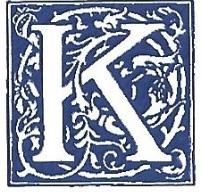
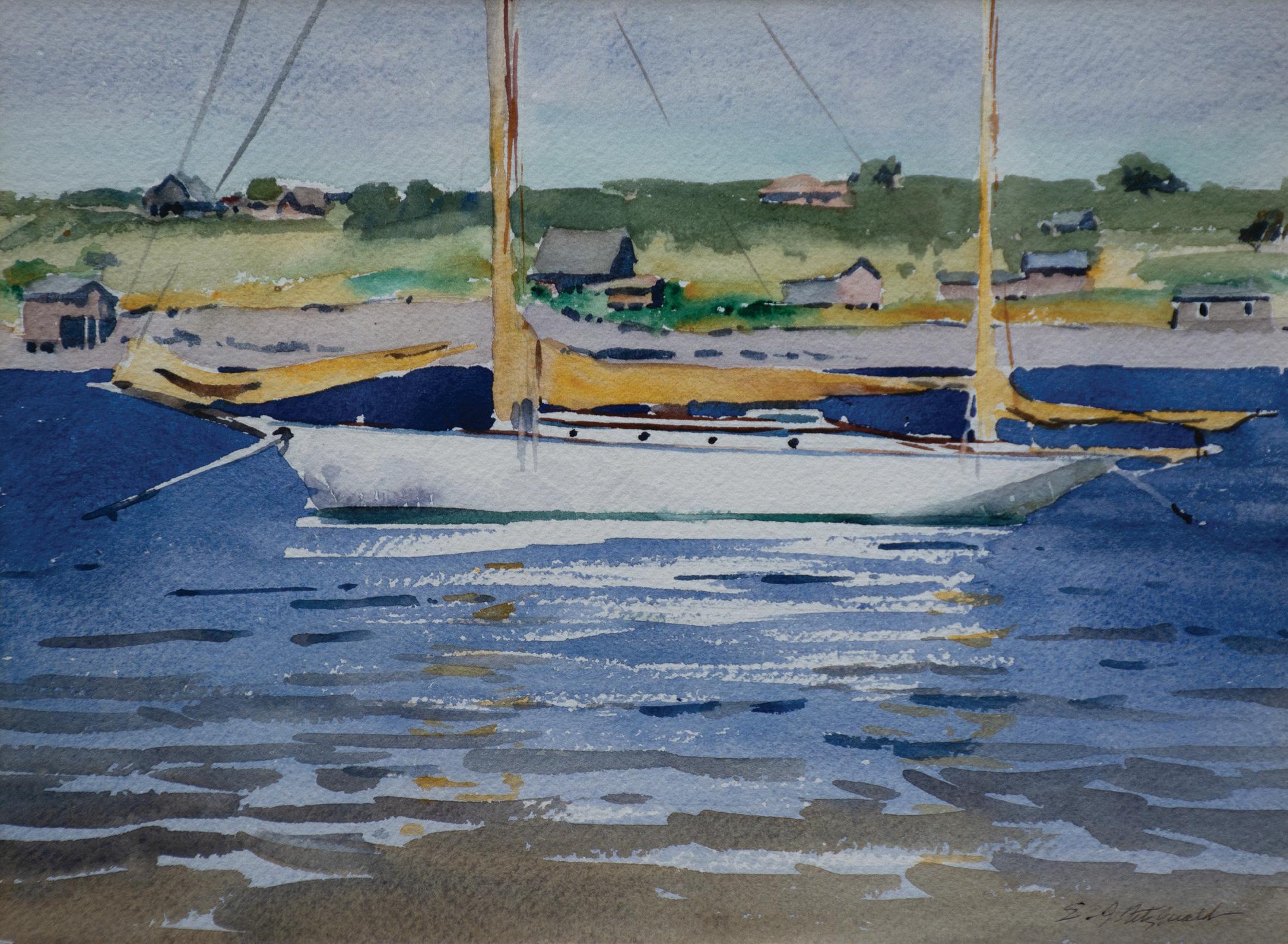
1 of 8
(American 1912-1989)
Sailboat Seattle Watercolor
10 x 14 3/8 inches
Signed lower right: E.J. Fitzgerald
www.ajkollar.com
By Appointment
(206) 323 - 2156
1421 E. Aloha Street Seattle, WA 98112
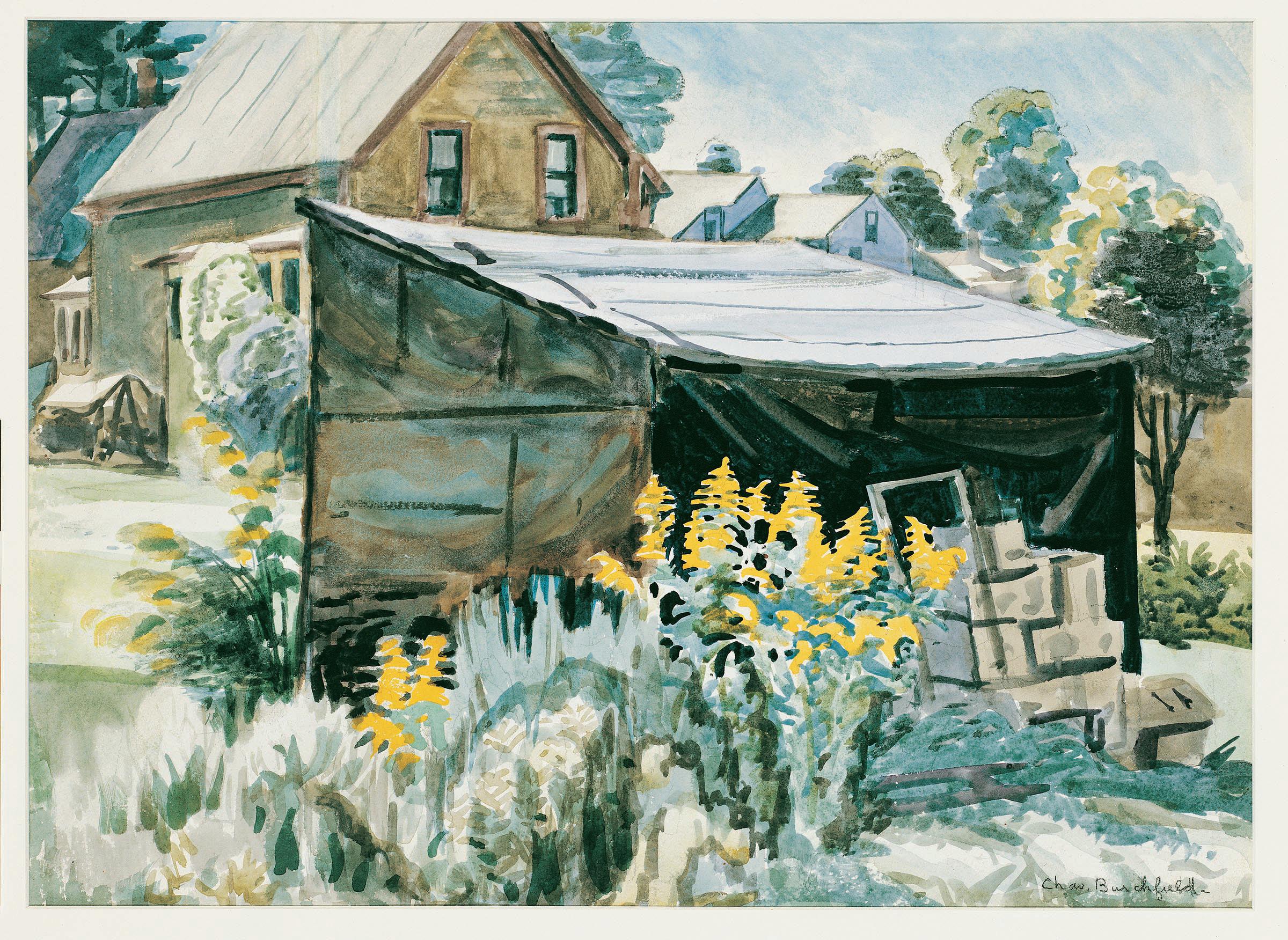
2 of 8
CHARLES BURCHFIELD (American 1893-1967)
Golden – Rod and Shed (Gardenville, New York)
Watercolor
15 x 20 inches
Signed lower right: Chas. Burchfield
Inscribed on reverse: Painted a number of years ago / at Gardenville New York at the/ time the property belonged to / Charles F. Goehle

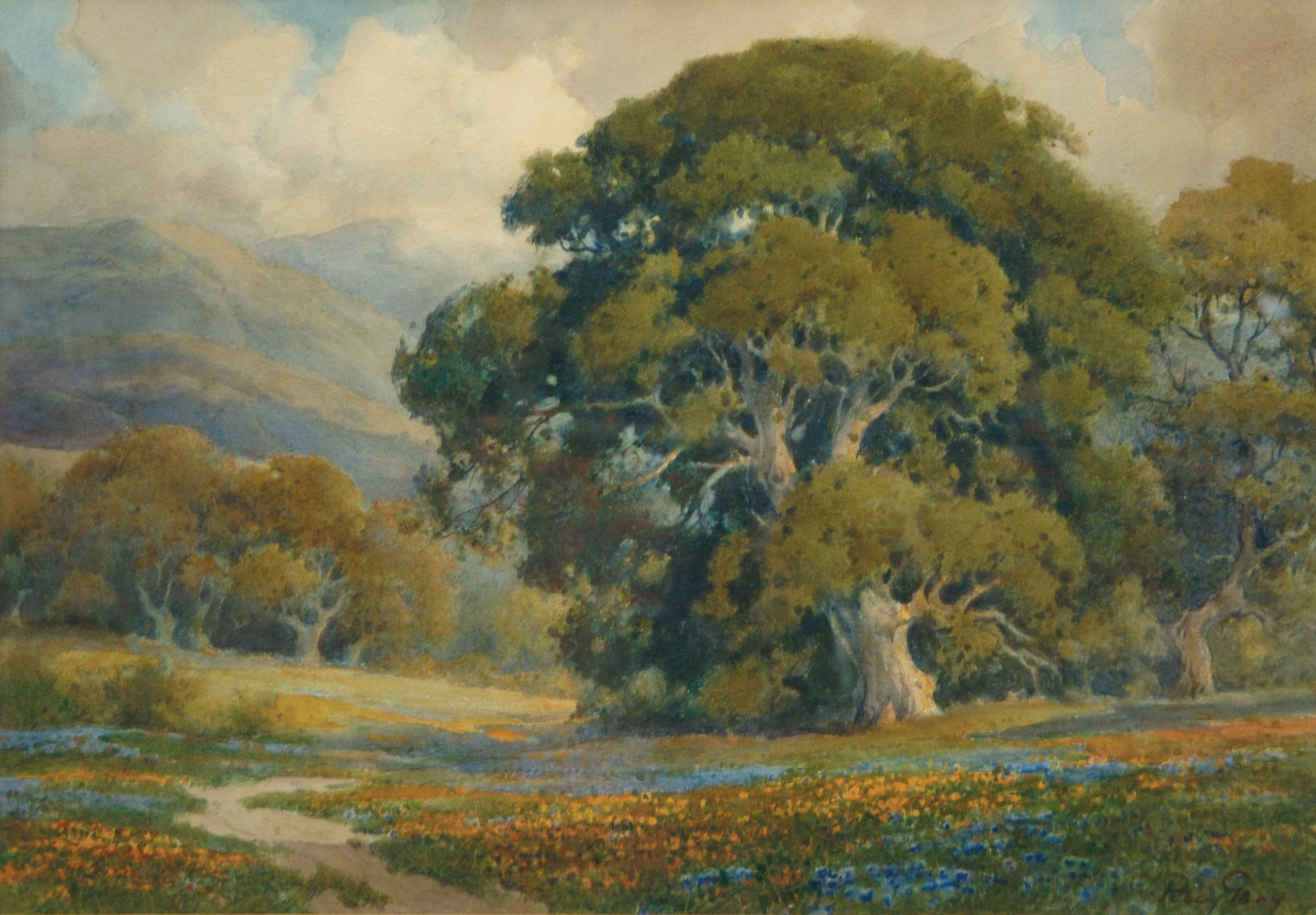
3 (on left) of 8 FREDERICK CARL FRIESEKE (American 1874-1939)
Scene in Holland 1898 Watercolor on paper
15.5 x 13 inches (sight size)
Signed, dated and inscribed lower left: F. Frieseke / Holland ‘98
4 (above) of 8 PERCY GRAY
(American 1869-1952)
Poppies and Lupines under the Oak Watercolor
20.5 x 29.25 inches (sight)
Signed lower right: Percy Gray

5 of 8
FREDERICK CHILDE HASSAM (American 1859-1935)
Weather Side of an Old House 1916
Watercolor on paper 15.25 x 22.25 inches
Signed and dated lower left: Childe Hassam 1916

6 of 8
HOLMES NICHOLLS (American 1854-1930)
Tasting the Mix
Watercolor and pencil on board
15.75 x 12.75 inches
Signed lower left: Rhoda / Holmes / Nicholls
Note:
Rhoda Holmes Nicholls was the second woman to be elected to the Roman Water Color Society in Italy. She later taught watercolor painting for William Merritt Chase at the Shinnecock Summer School of Art in addition to teaching at the Art Students League of New York, and in Cape Ann, Massachusetts. She exhibited extensively at the National Gallery of Design, the Pennsylvania Academy of the Fine Arts, the Brooklyn Art Association, the Boston Art Club and the Art Institute of Chicago.
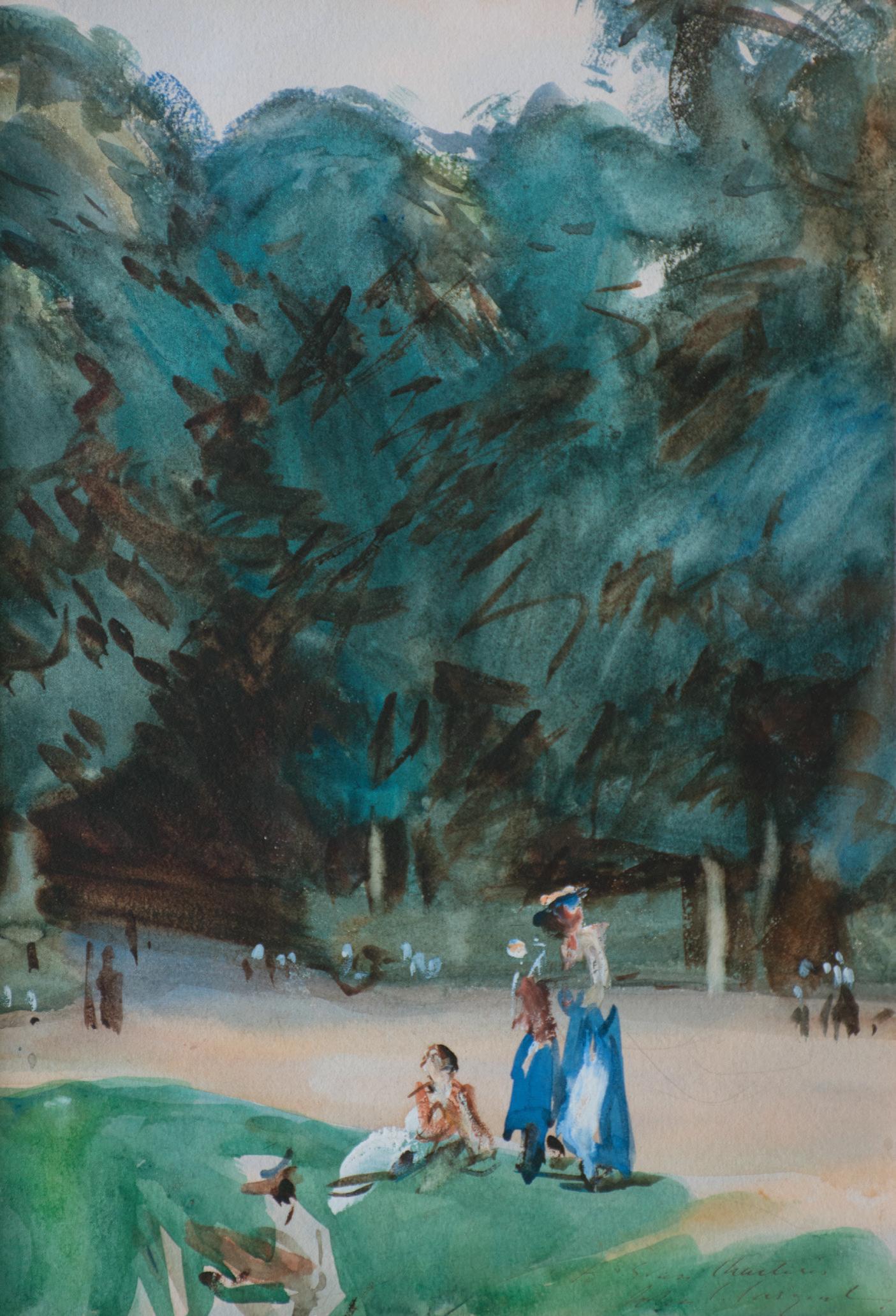
7 of 8
JOHN SINGER SARGENT
(American 1856-1925)
Near Versailles
Watercolor and Gouache on Paper
13.75 x 19.5 inches
Signed and inscribed lower right: To Evan Charles / John S. Sargent

8 of 8
(American 1876-1953)
Night Travelers
Circa 1929
Watercolor and gouache on paper
6 x 7 inches
Signed lower right: Everett Shinn
words by Scott Defrin
With the current patchwork of conflicting state laws across the United States, the market for antique objects containing African elephant ivory has been significantly chilled. State lawmakers, following a consistent false narrative perpetuated by animal welfare groups, have drafted regulations which are not only confusing and irrational, but are in direct conflict with the allowances provided for in the Federal Endangered Species Act (ESA), particularly the exemptions which permit antique ivory to be sold commercially across the nation.
Any states that have implemented laws regarding antique ivory do not have any jurisdiction when it comes to antique pieces being traded across state lines. These so-called intrastate commerce laws, which only pertain to activity within the boundaries of a state, do not overrule what federal law says can be done with bonafide antique objects that contain ivory, whether it be 1% or 100% of an object, when it comes to interstate (across state lines) commerce.
In 2016 the U.S. Fish and Wildlife Service (USFWS) finalized rules with respect to antique ivory under Directors Order 210. While it did not change the regulations pertaining to the allowances already contained in the ESA, it expanded certain allowances in order to accommodate the large body of worked ivory pieces that exist nationally. It is important to remember the following points:
Continue on page 63
1) Under certain circumstances, antique ivory (over 100 years old), following the guidelines, can be bought and sold across state lines without a specific permit or license. But an appraisal attesting to the piece being “antique” must be obtained and provenance provided showing the object has been in the U.S since before 1982.
2) Ivory objects which are under 100 years of age, and have been in the U.S. since before 1990 or imported legally after, can be bought and sold across state lines, if the object contains 50% or less ivory.
New York State does not permit any ivory to be bought or sold within the state. The ivory law is enforced by the NYS Department of Environmental Conservation (DEC), who can and will confiscate and/or destroy one’s property (regardless of its age and historical significance) and levy fines and/or seek prison for violators. The DEC, however, has a licensing apparatus in place which allows for the sale of antique ivory objects within the state (intrastate) if an object has 20% or less ivory. The license can be obtained by submitting an application to the DEC. The threshold for obtaining such a license is unreasonably high; the applicant must prove, incontrovertibly, that the piece is over 100 years old, by way of a marking found on the piece (e.g. hallmarks), a carver’s signature, publication or provenance dating back to over 100 years. They do not accept an expert’s opinion or appraisal, no matter how qualified that individual may be. The DEC also issues a license for antique objects which contain more than 20% ivory, but for out of state sales only (interstate); the same criteria apply in the application process but the sale of the object can only occur with the piece being physically transported out of the state. In other words, a New York resident cannot take delivery of an interstate-licensed object within the state; only an object licensed to be sold intrastate can be purchased and delivery can take place within the state. If, however, a New York resident wants to purchase
an interstate licensed piece, they can do so by (1) having the piece mailed to a location outside of New York and (2) then legally bringing the piece back into New York for their private or commercial use without breaking any laws. The New York DEC does not issue any license for objects that are under 100 years of age.
The NYS licensing procedure wasn’t, at its core, designed to allow for an easy process and prevent the sale of newly made ivory objects; on the contrary, it was designed to restrict any sale of ivory - however legitimate or historically/artistically noteworthy - to the maximum extent possible. Nevertheless, a buyer and a seller can conduct activity with antique ivory objects – if the transaction occurs outside NYS borders, or outside of any other state where such laws currently exist.
THE FOLLOWING SCENARIO WILL DESCRIBE HOW AN ANTIQUE IVORY OBJECT CAN BE SOLD WHILE ADHERING TO THE USFWS REGULATIONS AS PER ESA, WHILE AT THE SAME TIME AVOIDING RUNNING AFOUL WITH THE NEW YORK STATE REGULATIONS:
There is an individual in New York who has an antique ivory figure of a saint, which is made of 100% elephant ivory. The owner inherited the piece from his parents, who acquired it in 1977.
To satisfy the Federal regulations, the individual needs to obtain an ivory certification statement from an outside expert declaring that the object is verifiably antique and the owner signs an affidavit which speaks of the provenance of the piece, how they obtained it and how long it has been in the US. Additionally, a statement attesting that the object has not been modified with any new ivory elements after 1973 must be attained. Once the seller has these documents, they contact an antique dealer, either one in NY or outside of NY to sell it (owner needs to demonstrate that the object has been in the U.S since before 1982 or imported legally with a CITES after that date).
Continue on page 65
If the owner finds a NY dealer or anyone else to purchase it, the transaction cannot take place in NY. Because NY law prevents any commercial transaction to take place within the state and the procurement of a license from the DEC cannot be obtained due to denial of issuance, both individuals only need to meet in a neighboring state (such as Connecticut) to conduct the transaction. Payment and delivery of the piece can legally take place. The dealer can then bring the piece, over state lines, back into New York without breaking any laws.
If the owner finds an interested party outside of New York to purchase the unlicensed item, the owner needs to mail the object to the purchaser – but not from New York State. The object needs to be mailed from a location outside of New York, like a UPS or Fedex store in Connecticut (which does not have a state ivory law). New Jersey has even more restrictive ivory laws in place, therefore it is advisable to avoid that state entirely because you may be violating an aspect of their regulations. However, a licensed piece can be sold from an entity in New York to an entity in New Jersey if it is mailed or transported by a licensed DOT shipper.
This allowance in ESA, where the federal laws allow for interstate sales, can be followed by auction houses across the nation as well, under the same methodology, because the states cannot regulate interstate commerce where there is an exemption and/ or exception for antique ivory which has been properly vetted by a qualified specialist.
Currently, in New York State, as a result of recent Federal court proceedings, only dealers who are members of either the Art & Antique Dealers League of America or The National Art & Antique Dealers Association of America are permitted to display their licensed (both for intrastate & interstate) antique ivory pieces in their shops or at antique shows. Anyone else who procures a license from the DEC cannot physically display the
item, unless it is licensed to be sold within New York State. For pieces licensed to be sold out of New York State, an individual can only advertise those licensed pieces for sale in either a printed publication or in an online website or marketplace with a notice which says that “this object cannot be sold within New York State”.
The question begs, of course, why NYS even has the jurisdiction in requiring licenses to be issued for interstate commerce in the first place when the federal rules automatically engage when an interstate transaction occurs. This is an issue that will potentially be the subject of further litigation against the state.
Additionally, if a non-member of either organization procures a license, then that license can be transferred to an authorized seller in order to put the piece on display on their behalf.
In summary, in order to be in compliance and trade in antique ivory objects legally, it is important to conduct sales that follow the guidelines in ESA and essentially avoid conducting any business where there are state regulations in place. Because state laws only apply to conduct within the state, transactions that occur across state lines are perfectly legal. The states cannot restrict what the federal government allows regarding ivory and as long as any transaction does not take place where it is otherwise prohibited or strictly regulated, then the market can continue. It might be somewhat inconvenient, but if the value and/or historical significance of the objects warrants it, then it is certainly worth the effort. These laws are an impediment, but loopholes exist that provide for a workable environment.
Continue on page 67
Our devoted legal team at the Pacific Legal Foundation continues to challenge state laws on behalf of both the AADLA and NAADAA. These laws, however well-intentioned, encroach on the laws and regulations implemented by congress, and have unnecessarily diminished a venerable trade that has no nexus whatsoever with laws being broken on the African continent and the unfortunate depletion of the species. A writ of certiorari has been presented to the U.S Supreme Court to address this unequal patchwork of laws across the nation and hopefully it will settle this matter and fully declare that federal laws reign supreme over state laws which are in direct conflict where the intent of Congress has already been established.
For any questions or comments, please reach out to Scott Defrin at eurodecart@gmail.com
www.eurodecart.com
eurodecart@gmail.com
Gallery: 516-621-8300
Mobile: 516-643-1538
299 Main Street
Port Washington, N.Y. 11050
DOUGLAS STOCK GALLERY www.douglasstockgallery.com
Helen and Douglas Stock douglas@douglasstockgallery.com (781) 205-9817
21 Eliot Street (Route 16)
South Natick, MA 01760
The village of Heriz is located in northwest Persia's Azerbaijan province.
Several satellite villages in the area, along with Heriz itself, wove rugs in the late 19th and early 20th centuries, a period that is generally considered to make them "antique" in the field of Oriental rugs and carpets. To clarify, a "rug" is smaller than 6' x 9' and a "carpet" is larger.
Along with Heriz, the most notable villages to produce carpets in that period are Bakshaish and Karaja; and Bakshaish carpets are largely more of a 19th century product, with production there seeming to have stopped circa 1900, while Heriz and Karaja continued to produce beautiful examples into the 1920s, though the "best" examples were generally woven prior to circa 1900.
One often hears the term "Serapi" applied to rugs and carpets from this area but it is a colloquialism typically used to differentiate earlier examples from later pieces. As such, it is subject to both interpretation and misuse. We typically try to limit use of the term "Serapi" to rugs and carpets woven prior to circa 1910 and also tend to put the term in "quotes", generally following the name of the village where the piece was probably woven; e.g., An antique Heriz “Serapi"...
Although a fairly small number of rugs and carpets from this area can be quite finely woven, virtually none would rival examples woven in the Sarouk, Kashan or Tabriz areas in pure technical quality. That said, as is often the case with antique rugs, Heriz area rugs need to be compared with their peers rather than with examples from other regions and different
Continue on page 70

1 of 5
11' X 13'8" Antique Karaja “Serapi” Carpet
Heriz District, Northwest Persia, Circa 1890
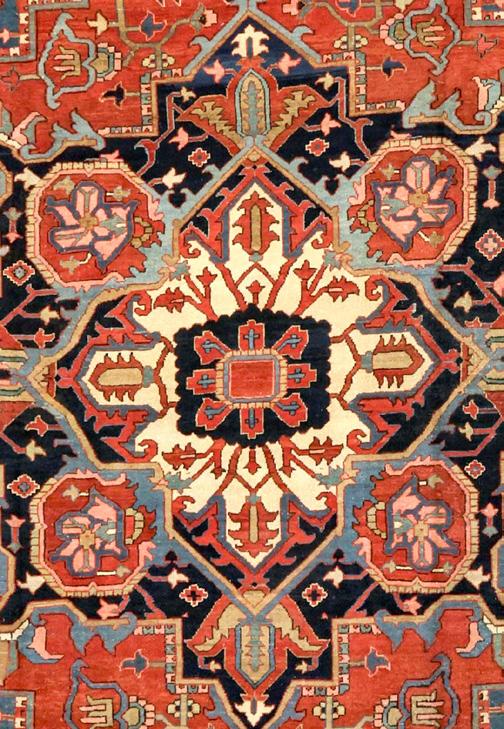
Outstanding 19th century carpets from the Heriz district in northwest Persia’s Azerbaijan province are prized for their beautiful palettes and geometric designs. A number of villages in the area, including Heriz itself, Karaja, Bakshaish and Goravan, wove carpets, though Goravan carpets seem to date to no earlier than circa 1910. Heriz, Karaja and Bakshaish carpets from the 19th century are often superlative in their color quality and the designs often reflect a charming and slightly archaic character. These early examples are often referred to colloquially as antique “Serapi” carpets, although there is no village by that name and if analyzed far enough the concept essentially disappears into thin air.
This carpet, identifiable as having been woven in the village of Karaja due to the single knotted construction which Karaja is the only village in the area to employ, is distinctive in several respects, most notably the wide, yellow “Turtle” design border. The carpet is also somewhat more square than typical.
This carpet would serve beautifully as the foundation for a room decorated with period American or English antiques. It would also go well in a more modern setting, where its warm colors and whimsical design would soften the often stark appearance of modern furniture and decorative arts.
This carpet is published in the September 2024 issue of The Magazine Antiques.
criteria raises or lowers them in a hierarchy of examples. Color, articulation and spacing of design elements and wool quality are far more important than knot count in Heriz weavings.
As is the case with virtually all antique rugs, the best way to determine where a piece was woven is to examine the weave. In the case of rugs from the Heriz area, the finest examples produced in Heriz itself, especially the early "Serapi" types, are typically the most finely woven of all rugs from that region. They have a double knotted construction, meaning each individual knot has one half stacked over the other. In the case of Heriz rugs, the weave is often "off-set" rather than directly stacked like a Bidjar would typically be. Bakshaish carpets are generally more coarsely woven with a pliable handle. However, since they are typically among the oldest examples from the area and are famous for their colors and archaic designs, they can be among the most valuable. Karaja rugs are an anomaly for this region in having a "single knot" construction, with both warp (vertical foundation) threads contiguous on a flat plane. Early Karaja carpets can be among the most beautiful of all "Serapi" carpets.
Renowned for their geometric designs and their crisp natural dyes, Heriz area rugs and carpets are among the most favored types of carpets for "period" interiors but can also be a great foundation for a modern room.
Please, feel free to call or e-mail Helen and Douglas Stock at Douglas Stock Gallery at (781) 205-9817 or douglas@ douglasstockgallery.com if you would like to learn more about these colorful and charming weavings. Douglas Stock Gallery is a 34 year member of The Art & Antique Dealers League of America and is based in the Boston area with a national clientele.

2 of 5
4’8" x 5’3" Antique Heriz “Serapi” Rug Northwest Persia, Cira 1890
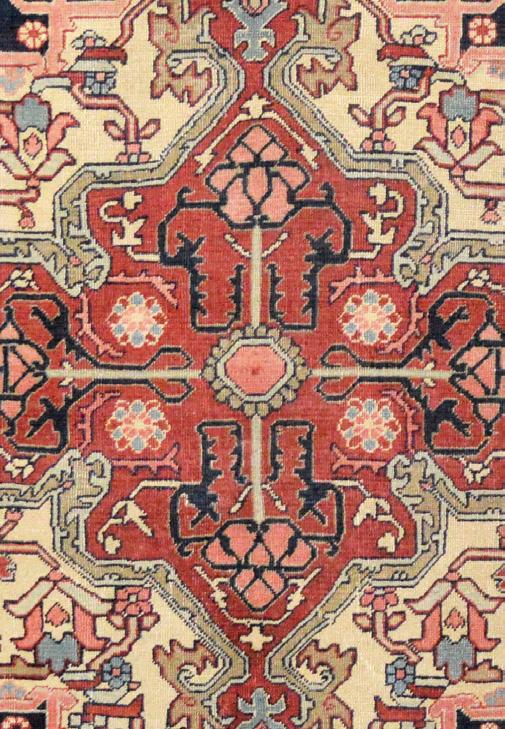
Antique Heriz rugs of the early type, often colloquially referred to as antique “Serape” rugs, are prized for warm colors and geometric designs. Ivory field examples are especially uncommon. This rug features a brick red medallion with camel color trim on an ivory field. Navy blue corner spandrels with apple green insets and a brick red border with beautiful drawing and of grand scale, complemented by sky blue guard borders, frame the field.
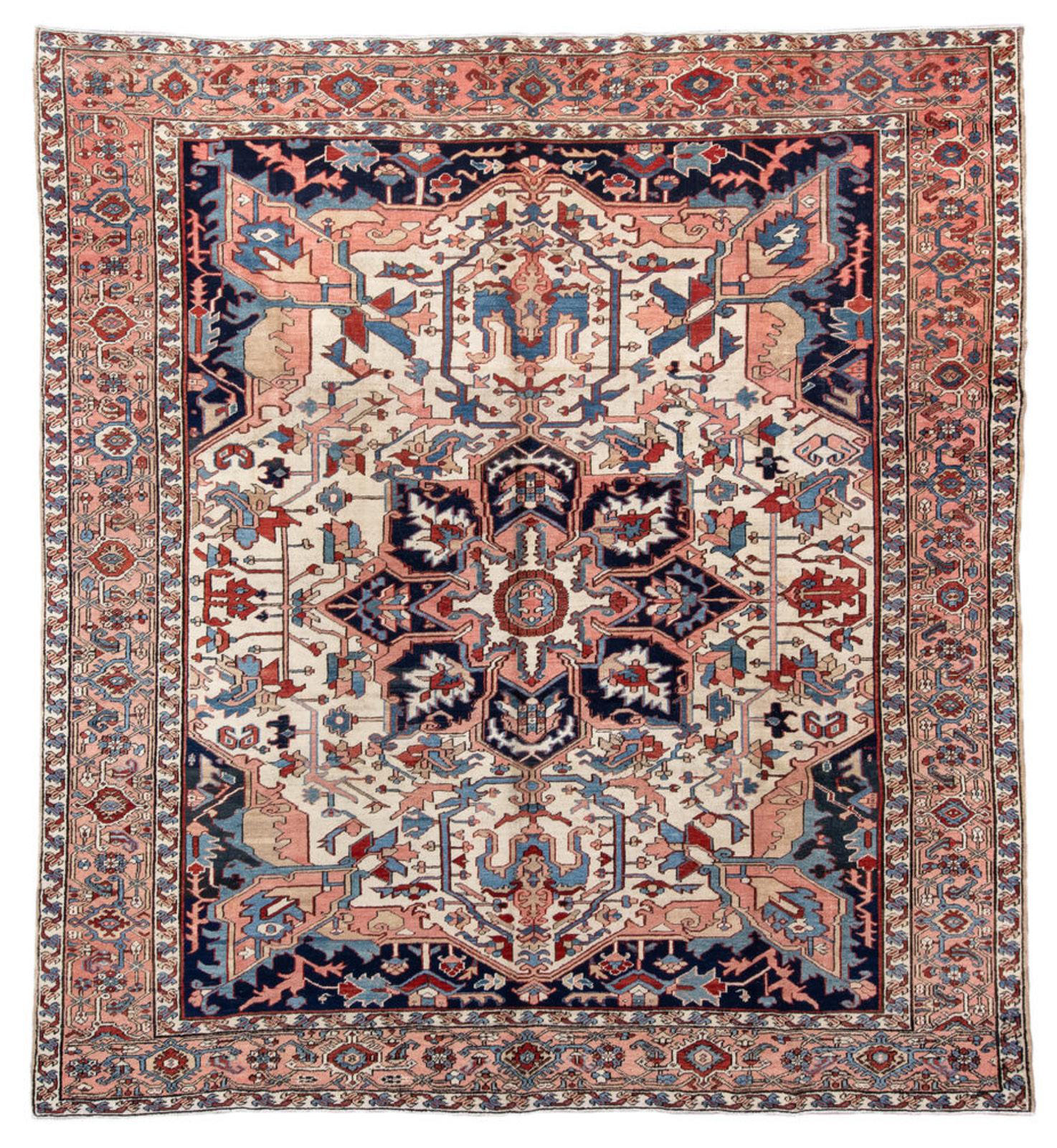
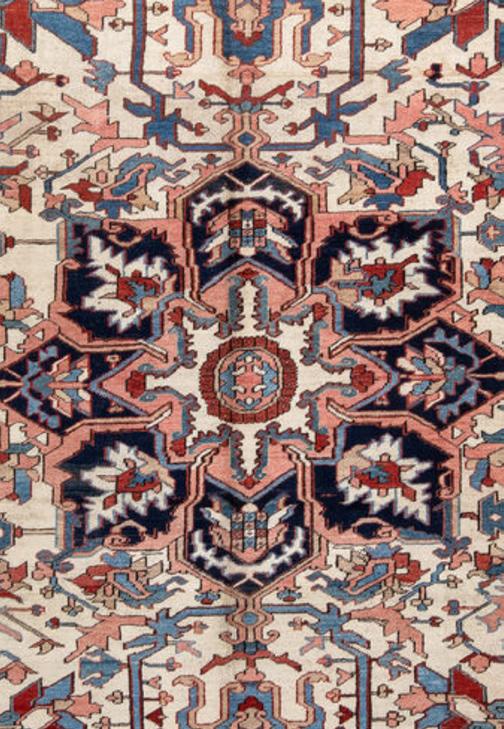
4’8"
Northwest Persia, Cira 1890
A northwest Persian Heriz carpet of the age and caliber where examples are often referred to colloquially as antique “Serapi” carpets. This carpet has several distinctive features. The squarish size is uncommon; ivory field examples are generally prized; and the coral color border is uncommon and goes beautifully with the other colors.
Antique Heriz “Serapi” carpets are the quintessential choice for rooms decorated in a “period” style. They are also one of the best choices for modern rooms, given their geometric drawing.
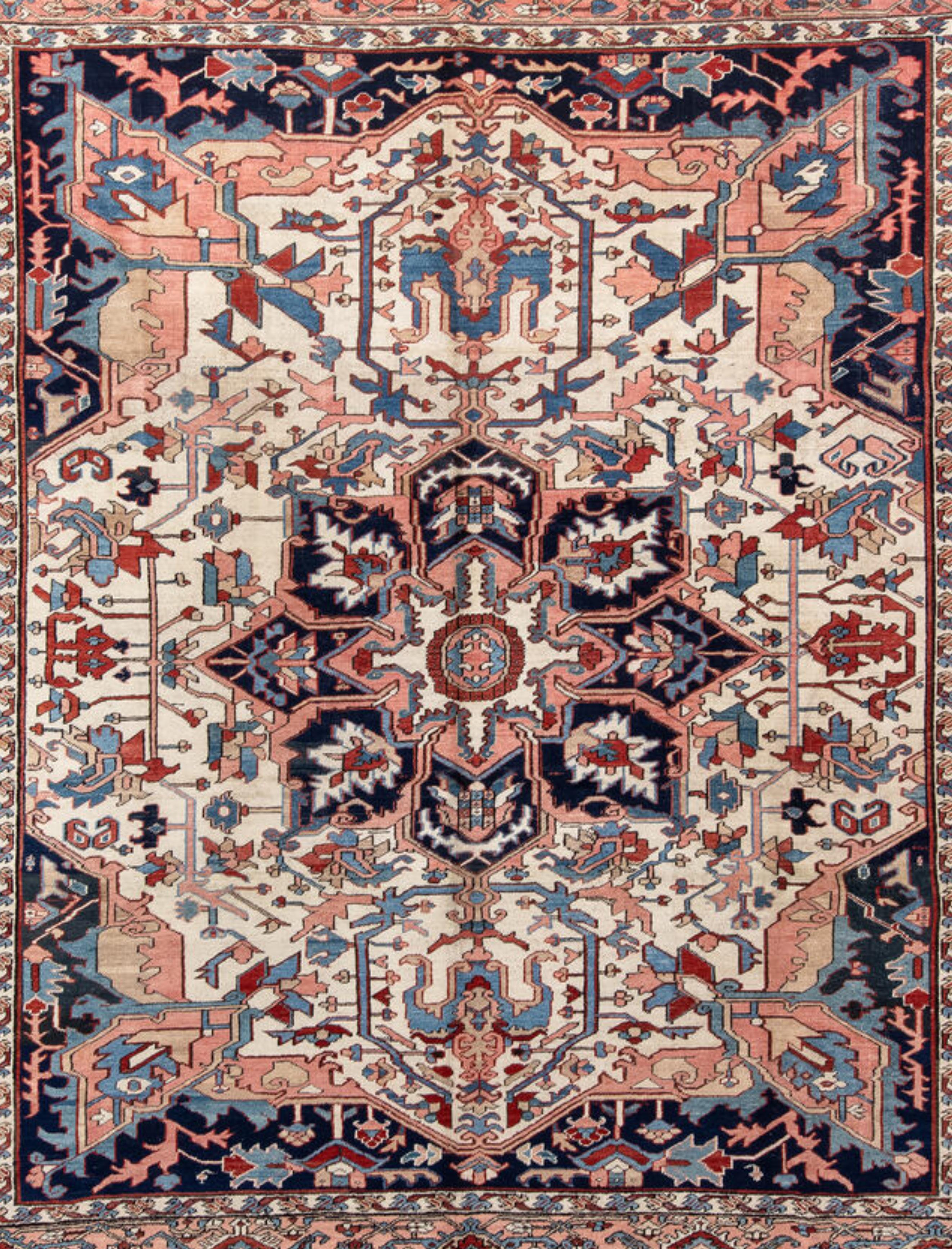

4 of 5
13’5" x 18’7" An Important Antique Bakshaish Carpet With Shrub Design
Heriz District, Northwest Persia, Circa 1890
A world class over size antique Bakshaish carpet from the Heriz district in northwest Persia. This exceptional antique Bakshaish carpet features a Shrub design on an ivory field. A sky blue leaf and flowerhead border frames the field.
A wide range of colors distinguishes this Bakshaish carpet, including yellow, green, salmon, ivory, sky blue and brown.
Although ostensibly similar to the Bid Majnun design of Cypress and Willow trees seen in northwest Persian carpets from both the Bidjar area in Kurdistan Province and the Heriz area in Azerbaijan, the Shrub design featured in this Bakshaish carpet is much less common.
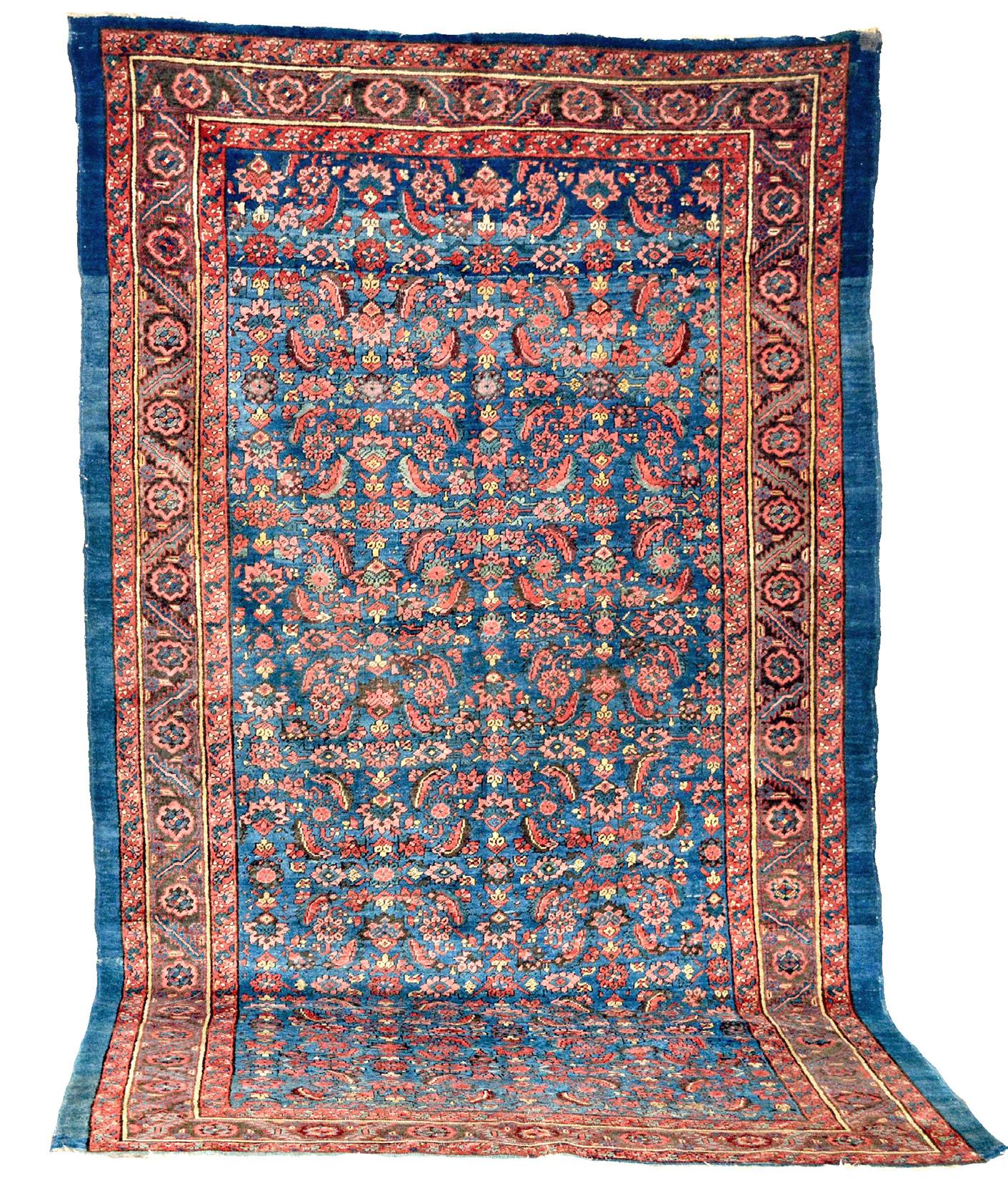
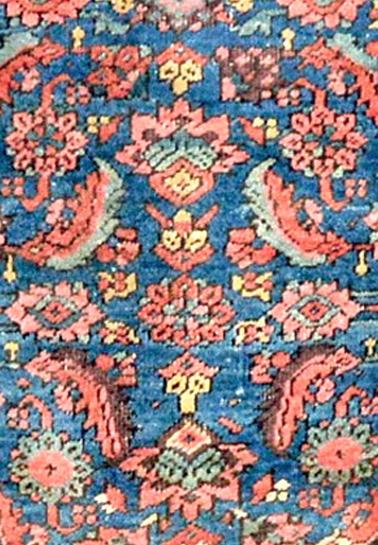
5 of 5
6" x 10’8" Antique Bakshaish Carpet, Herati Design
Northwest Persia, Circa 1890
Bakshaish carpets were woven in the Heriz district in northwest Persia’s Azerbaijan province. Unlike some of the other villages in that area, such as Heriz itself, Karaja, Goravan and Mehriban, carpet production in Bakshaish appears to have ended shortly after 1900.
This late 19th century Bakshaish example is distinctive both in the long and narrow “gallery carpet” size, which follow an early classical period paradigm, and in having a beautiful denim blue field.
The field is decorated with the most famous of all Persian classical designs, the “Herati" design, but the articulation of it here is unusual in that the diamond shaped motifs typically seen are absent, with the flowerhead, palmettes and leaves all present.
AADLA MEMBERS: L'ANTIQUAIRE & THE CONNOISSEUR, INC. • KELLY KINZLE ANTIQUES • KAPOOR GALLERIES
• EUROPEAN DECORATIVE ARTS COMPANY • CLINTON
HOWELL ANTIQUES • A LA VIEILLE RUSSIE • A.J. KOLLAR FINE PAINTINGS, LLC • ANDERSON GALLERIES •
ANTIQUARIUM • BETTY KRULIK FINE ART LTD. • BRAD & VANDY REH • CAMILLA DIETZ BERGERON • CARLTON HOBBS
LLC • CHARLES CHERIFF GALLERIES • CHRISTOPHER
BISHIP FINE ART • DALVA BROTHERS, INC. • RICHARD A. BERMAN FINE ART • DAPHNE ALAZRAKI FINE ART • DAVID NELIGAN ANTIQUES • DOUGLAS STOCK GALLERY
• EARLE D. VANDEKAR OF KNIGHTSBRIDGE, INC. • ENGSDIMITRI WORKS OF ART • FIND WEATHERLY • FRAMONT
• G. SERGEANT ANTIQUES, LLC • GALERIE RIENZO, LTD. •
GEORGE GLAZER • GODEL & CO. FINE ART • HIXENBAUGH
ANCIENT ART LTD. • HYDE PARK ANTIQUES, LTD • ILIAD
• J.N. BARTFIELD GALLERIES • JAMES ROBINSON, INC. • JAYNE THOMPSON ANTIQUES • JULIUS LOWY FRAME & RESTORING CO. • YEW TREE HOUSE ANTIQUES • MAISON
GERARD • MARCY BURNS AMERICAN INDIAN ART • MARY HELEN MCCOY FINE ANTIQUES • MEDUSA ANCIENT ART, LTD. • MICHAEL PASHBY ANTIQUES • O'SULLIVAN ANTIQUES • PAUL M. HERTZMANN, INC. • PHILIP COLLECK, LTD. • PHOENIX ANCIENT ART • PREHISPANICO • R. KALLERKIMCHE INC. • REHS GALLERIES, INC • ROBERT MORRISSEY ANTIQUES • ROBERT SIMON FINE ART • ROBYN TURNER GALLERY • SCHILLAY FINE ART, INC • SPENCER MARKS, LTD. • STEPHEN RUSSELL • THE ROMAN GORONOK COMPANY • THOMAS K. LIBBY • LILLIAN NASSAU •

AADLA invites you to support Himalayan Art Resources: A comprehensive education and research database and virtual museum of Himalayan art. Discover a wealth of knowledge at HimalayanArt.org

The Art and Antique Dealers League of America, Inc. is the oldest and principal antiques and fine arts organization in America. Learn more at AADLA.com
Interested in working with the AADLA? Reach out to us via email: info@aadla.com